Paul van Yperen's Blog, page 52
April 27, 2024
Wendy Barrie
British-American actress Wendy Barrie (1912-1978) had her breakthrough with The Private Life of Henry VIII (1932). In the following years, she would act with major Hollywood stars such as Spencer Tracy, James Stewart and Humphrey Bogart. By the 1940s, her star began to fade. This was partly due to the bad publicity generated by her real-life role as the mistress of notorious underworld figure Bugsy Siegel. In the late 1940s, she made a comeback on television. Barrie appeared in more than 15 films in Britain and more than 30 in Hollywood.
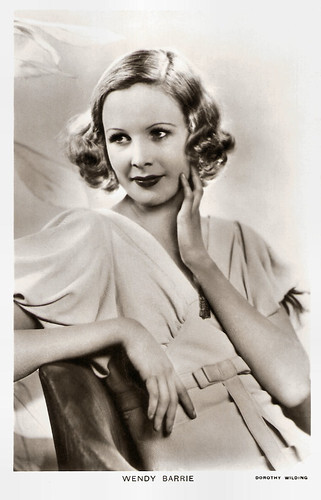
British postcard in the Picturegoer Series, London, no. 730a. Photo: Dorothy Wilding.
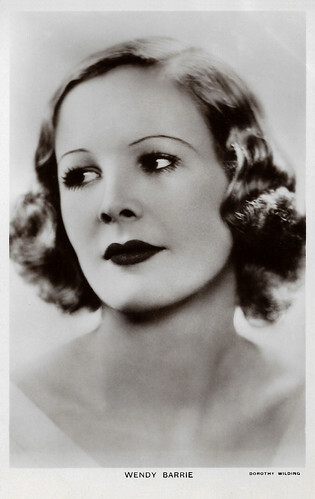
British postcard in the Picturegoer Series, London, no. 730. Photo: Dorothy Wilding.
A blonde, vivacious lass with innocent charm and an instinctive acting ability
Wendy Barrie was born Marguerite Wendy Jenkin(s) in 1912 in British Hong Kong, to English parents. Her father, Francis Charles John Graigoe Jenkin(s), was a British lawyer. Her mother was Ellen McDonagh or Sarah Cohen (the sources differ), a Russian-Jewish actress who had performed in the world's first professional Yiddish-language theatre troupe. Her godfather and future stage namesake was the Scottish novelist-playwright, Sir J.M. Barrie, in whose play 'Peter Pan' was a character called Wendy.
She received her education at a convent school in England and a finishing school in Switzerland. As a teenager, she began pursuing a career as an actress, helped by her red-gold hair and blue eyes. She adopted the stage name Wendy Barrie and played at the London Savoy Theatre in 'Wonder Bar' (1930). In 1932, she made her film debut in the British drama Threads (G.B. Samuelson, 1932).
She was then signed to make several motion pictures for London Films under the Korda brothers, Zoltan Korda and Alexander Korda. She soon had her first major success with her role as Jane Seymour, the third of the six wives of King Henry VIII of England in The Private Life of Henry VIII (Alexander Korda, 1933) alongside Charles Laughton and Merle Oberon. The film was a major international success, establishing Korda as a leading filmmaker and Laughton as a box-office star.
Hollywood soon also beckoned for Barrie. In 1934, she went to America where Fox signed her. During the next decade, she found regular employment at Paramount (1935), Universal (1936-1938) and RKO (1938-1942). I.S. Mowis at IMDb : "A blonde, vivacious lass with a certain innocent charm and an instinctive acting ability, she tended to play mostly ingenue roles in minor films and often rose above her material." Her American film debut was the screwball comedy It's a Small World (Irving Cummings, 1934) in which she co-starred with Spencer Tracy . It was followed by the romantic comedy Under Your Spell (Otto Preminger, 1936) with opera baritone Lawrence Tibbett. In 1936 she was loaned to MGM and played in Speed (Edwin L. Marin, 1936) alongside James Stewart in his first starring role.
Barrie starred alongside Humphrey Bogart in the social drama Dead End (William Wyler, 1937). Two years later, the Sherlock Holmes classic The Hound of the Baskervilles (Sidney Lanfield, 1939) followed, in which she played the female lead alongside Basil Rathbone and Richard Greene . Craig Butler at AllMovie : "The first of the long and successful series of Basil Rathbone Sherlock Holmes films, The Hound of the Baskervilles is smashing good fun for Holmes enthusiasts and fans of the detective thriller genre. Set in the appropriately spooky moors, Hound is an engaging adaptation of the Arthur Conan Doyle original -- respectful but not slavish, and unafraid to make changes to make the film more interesting cinematically." She co-starred with Lucille Ball in the melodrama Five Came Back (John Farrow, 1939). Her Hollywood career alternated between leads in B movies and supporting roles in bigger films.
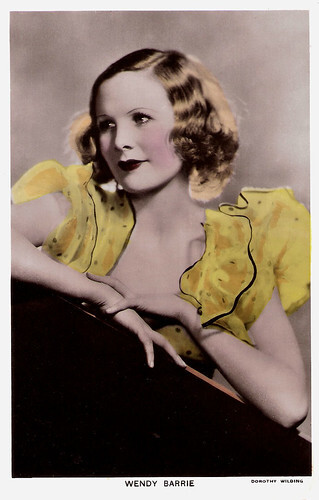
British postcard in the Colourgraph Series, London, no. C 189. Photo: Dorothy Wilding.
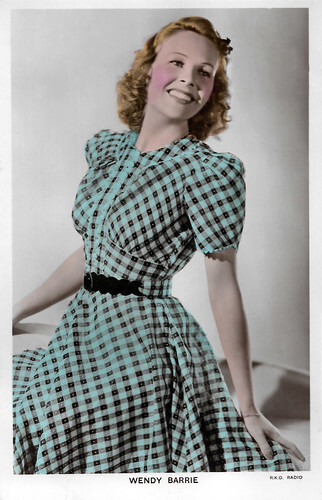
British postcard in the Colourgraph Series, London, no. C 355. Photo: R.K.O. Radio.
Engaged to infamous gangster Bugsy Siegel
During 1939 and the early 1940s, Wendy Barrie made several of The Saint and The Falcon mystery films with George Sanders . At the end of the 1930s, she was a member of the cast of The Jack Haley Show on NBC (1937-1938) and CBS (1938-1939). She became a naturalised American citizen in 1942 and was attired in the uniform of the women's ambulance and transport corps.
In the 1940s, Wendy Barrie focused on radio and television. She was an assistant on the Star for a Night radio program on the Blue Network (1943-1944), and she was one of the quizmasters on Detect and Collect on CBS (1945) and ABC (1945-1946). In 1956, she had a disc jockey program, the Wendy Barrie Show, on WMGM in New York City. She also hosted a widely syndicated radio interview show into the mid-1960s.
She only acted occasionally in television programs, such as in the children's comedy The Adventures of Oky Doky (1948) featuring a cowboy puppet. In the same year, she decided to embark on what turned out to be a successful new career as television host of her pioneering talk show on daytime television, Picture This (1948), followed by The Wendy Barry Show (1948-1950). Her trademark sign-off was "Be a good bunny".
Her relaxed, informal style brought her great popularity and plaudits from television critics like Jack Gould of the New York Times. That program was replaced by Through Wendy's Window in August 1950. The 15-minute NBC program had Barrie interviewing celebrities and talking about fashions. She continued appearing on network television on panel shows in the early 1950s and as a spokesperson for commercial products, including a stint as the original Revlon saleswoman on The $64,000 Question. In 1950, she performed as a substitute for Jean Arthur in 'Peter Pan', along with Boris Karloff , at the Imperial Theatre, in New York City.
Her last film was the comedy It Should Happen to You (George Cukor, 1954) with Judy Holliday. In 1962, Wendy Barrie stopped acting. In the mid-1970s, she suffered a stroke which affected her mental state and she spent the last years of her life at a nursing home in Englewood, New Jersey. There she died in 1978 at the age of 65. She is buried at the Kensico Cemetery in Valhalla, New York. Wendy Barrie has a star on the Hollywood Walk of Fame (1708 Vine Street). Wendy Barrie was reportedly engaged to and had a daughter named Carolyn with the infamous gangster Benjamin 'Bugsy' Siegel. Later, she was married to textile manufacturer David L. Meyer.
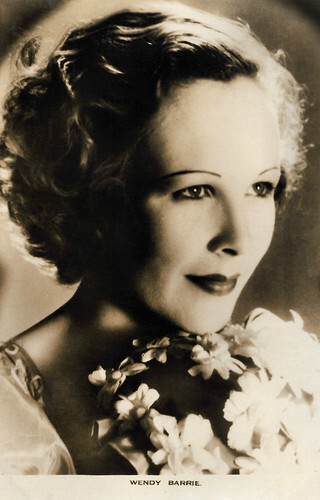
British postcard by Film Weekly, London.
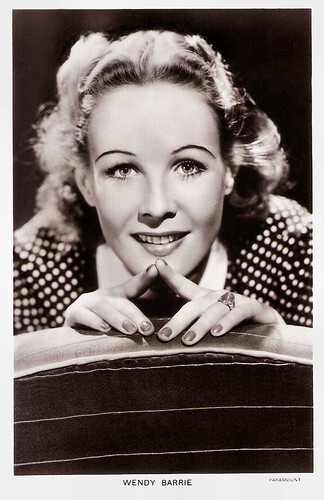
British postcard in the Picturegoer Series, London, no. 730c. Photo: Paramount.
Sources: (IMDb), Craig Butler (AllMovie), Hollywood Walk of Fame, Wikipedia (Dutch, German and English) and .

British postcard in the Picturegoer Series, London, no. 730a. Photo: Dorothy Wilding.

British postcard in the Picturegoer Series, London, no. 730. Photo: Dorothy Wilding.
A blonde, vivacious lass with innocent charm and an instinctive acting ability
Wendy Barrie was born Marguerite Wendy Jenkin(s) in 1912 in British Hong Kong, to English parents. Her father, Francis Charles John Graigoe Jenkin(s), was a British lawyer. Her mother was Ellen McDonagh or Sarah Cohen (the sources differ), a Russian-Jewish actress who had performed in the world's first professional Yiddish-language theatre troupe. Her godfather and future stage namesake was the Scottish novelist-playwright, Sir J.M. Barrie, in whose play 'Peter Pan' was a character called Wendy.
She received her education at a convent school in England and a finishing school in Switzerland. As a teenager, she began pursuing a career as an actress, helped by her red-gold hair and blue eyes. She adopted the stage name Wendy Barrie and played at the London Savoy Theatre in 'Wonder Bar' (1930). In 1932, she made her film debut in the British drama Threads (G.B. Samuelson, 1932).
She was then signed to make several motion pictures for London Films under the Korda brothers, Zoltan Korda and Alexander Korda. She soon had her first major success with her role as Jane Seymour, the third of the six wives of King Henry VIII of England in The Private Life of Henry VIII (Alexander Korda, 1933) alongside Charles Laughton and Merle Oberon. The film was a major international success, establishing Korda as a leading filmmaker and Laughton as a box-office star.
Hollywood soon also beckoned for Barrie. In 1934, she went to America where Fox signed her. During the next decade, she found regular employment at Paramount (1935), Universal (1936-1938) and RKO (1938-1942). I.S. Mowis at IMDb : "A blonde, vivacious lass with a certain innocent charm and an instinctive acting ability, she tended to play mostly ingenue roles in minor films and often rose above her material." Her American film debut was the screwball comedy It's a Small World (Irving Cummings, 1934) in which she co-starred with Spencer Tracy . It was followed by the romantic comedy Under Your Spell (Otto Preminger, 1936) with opera baritone Lawrence Tibbett. In 1936 she was loaned to MGM and played in Speed (Edwin L. Marin, 1936) alongside James Stewart in his first starring role.
Barrie starred alongside Humphrey Bogart in the social drama Dead End (William Wyler, 1937). Two years later, the Sherlock Holmes classic The Hound of the Baskervilles (Sidney Lanfield, 1939) followed, in which she played the female lead alongside Basil Rathbone and Richard Greene . Craig Butler at AllMovie : "The first of the long and successful series of Basil Rathbone Sherlock Holmes films, The Hound of the Baskervilles is smashing good fun for Holmes enthusiasts and fans of the detective thriller genre. Set in the appropriately spooky moors, Hound is an engaging adaptation of the Arthur Conan Doyle original -- respectful but not slavish, and unafraid to make changes to make the film more interesting cinematically." She co-starred with Lucille Ball in the melodrama Five Came Back (John Farrow, 1939). Her Hollywood career alternated between leads in B movies and supporting roles in bigger films.

British postcard in the Colourgraph Series, London, no. C 189. Photo: Dorothy Wilding.

British postcard in the Colourgraph Series, London, no. C 355. Photo: R.K.O. Radio.
Engaged to infamous gangster Bugsy Siegel
During 1939 and the early 1940s, Wendy Barrie made several of The Saint and The Falcon mystery films with George Sanders . At the end of the 1930s, she was a member of the cast of The Jack Haley Show on NBC (1937-1938) and CBS (1938-1939). She became a naturalised American citizen in 1942 and was attired in the uniform of the women's ambulance and transport corps.
In the 1940s, Wendy Barrie focused on radio and television. She was an assistant on the Star for a Night radio program on the Blue Network (1943-1944), and she was one of the quizmasters on Detect and Collect on CBS (1945) and ABC (1945-1946). In 1956, she had a disc jockey program, the Wendy Barrie Show, on WMGM in New York City. She also hosted a widely syndicated radio interview show into the mid-1960s.
She only acted occasionally in television programs, such as in the children's comedy The Adventures of Oky Doky (1948) featuring a cowboy puppet. In the same year, she decided to embark on what turned out to be a successful new career as television host of her pioneering talk show on daytime television, Picture This (1948), followed by The Wendy Barry Show (1948-1950). Her trademark sign-off was "Be a good bunny".
Her relaxed, informal style brought her great popularity and plaudits from television critics like Jack Gould of the New York Times. That program was replaced by Through Wendy's Window in August 1950. The 15-minute NBC program had Barrie interviewing celebrities and talking about fashions. She continued appearing on network television on panel shows in the early 1950s and as a spokesperson for commercial products, including a stint as the original Revlon saleswoman on The $64,000 Question. In 1950, she performed as a substitute for Jean Arthur in 'Peter Pan', along with Boris Karloff , at the Imperial Theatre, in New York City.
Her last film was the comedy It Should Happen to You (George Cukor, 1954) with Judy Holliday. In 1962, Wendy Barrie stopped acting. In the mid-1970s, she suffered a stroke which affected her mental state and she spent the last years of her life at a nursing home in Englewood, New Jersey. There she died in 1978 at the age of 65. She is buried at the Kensico Cemetery in Valhalla, New York. Wendy Barrie has a star on the Hollywood Walk of Fame (1708 Vine Street). Wendy Barrie was reportedly engaged to and had a daughter named Carolyn with the infamous gangster Benjamin 'Bugsy' Siegel. Later, she was married to textile manufacturer David L. Meyer.

British postcard by Film Weekly, London.

British postcard in the Picturegoer Series, London, no. 730c. Photo: Paramount.
Sources: (IMDb), Craig Butler (AllMovie), Hollywood Walk of Fame, Wikipedia (Dutch, German and English) and .
Published on April 27, 2024 22:00
April 26, 2024
Margaret Lee (1943-2024)
On 24 April 2024, cool and beautiful Margaret Lee (1943) passed away. She posed as a glamorous starlet for many international magazines throughout the 1960s. Between 1962 and 1983 the British born actress co-starred in over 70 European films. She was 80.
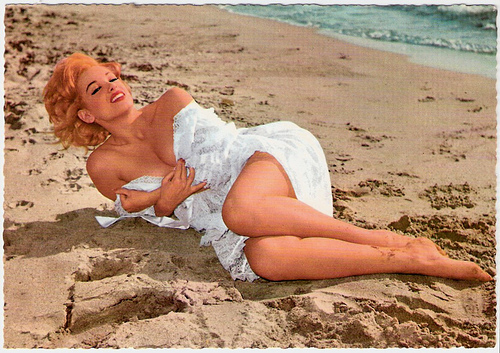
German postcard by Krüger, no. 902/361. Photo: Georg Michalke.
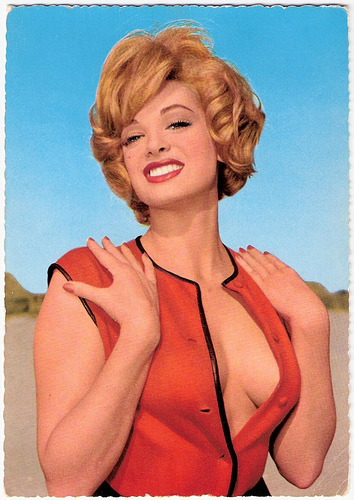
German postcard by Kruger, no. 902/356. Photo: Georg Michalke.
Blonde, fluffy look
Margaret (sometimes credited as Margareth) Lee was born Margaret Gwendolyn Box in Wolverhampton, England in 1943. Her mother, who lived in wartime London, was evacuated because of the bombing to a family in Wolverhampton in the West Midlands, whom she had never met before. After the bombing ended mother and daughter returned to London, and Margaret grew up there. She was educated at Roan Grammar School in Greenwich and later studied for three years at the Italia Conti Theatre School in London.
Margaret Lee in an interview with the blog Du dumme Sau! : "I wanted to act in the Theatre (never thought of films) and was willing to take any path that might lead me there. I read in The Stage of auditions for showgirls at the famous Moulin Rouge in Paris. I was 17. I wanted to get away from home, and so I auditioned and was taken on. Then almost a year later, a friend told me they were interviewing for small parts in Cleopatra with Elizabeth Taylor in Rome. I auditioned and was accepted. Within two weeks I was in Rome and going to Cinecitta Film Studios each day. In the end, however, many hours of the film were cut, including my appearances."
At the set of Cleopatra (Joseph L. Mankiewicz, 1963), she met Gino Malerba, who worked as an assistant to choreographer Hermes Pan. When the filming of Cleopatra ended he introduced her to an agent, Fillipo Fortini. They both hoped in this way Lee could get work as an actress in Rome and not have to return to London. It worked and Malerba and Lee would later marry.
She made her screen debut in Maciste contro i mostri/Fire Monsters Against the Son of Hercules (Guido Malatesta, 1962) opposite bodybuilder Reg Lewis. With a blonde, fluffy look modelled after Marilyn Monroe , Lee followed it up with a stream of low-budget Peplum spectacles, comedies and thrillers. Some of them are now considered cult films.
Highlights include Gli Imbroglioni/The Swindlers (Lucio Fulci, 1963) with Walter Chiari , the comedy In ginocchio da te/On My Knees For You (Ettore Maria Fizzarotti, 1964) starring singer Gianni Morandi , Questa volta parliamo di uomini/Let's Talk About Men (Lina Wertmüller, 1965) with Nino Manfredi , and Casanova '70 (Mario Monicelli, 1965) with Marcello Mastroianni . She appeared in several comedies and parodies which starred the popular comedic duo Franco Franchi and Ciccio Ingrassia. Few of these films received much (if any) distribution in foreign territories, but they were highly successful in Italy and made Lee a well-known film actress there.
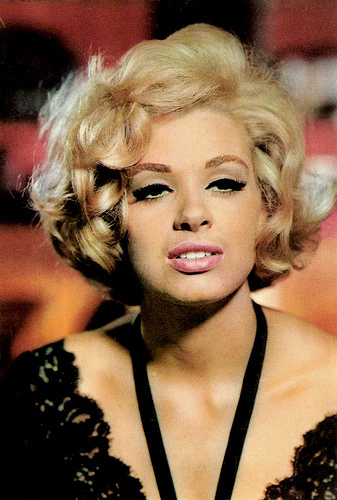
Israelian postcard by Éditions de Luxe, no. 123.
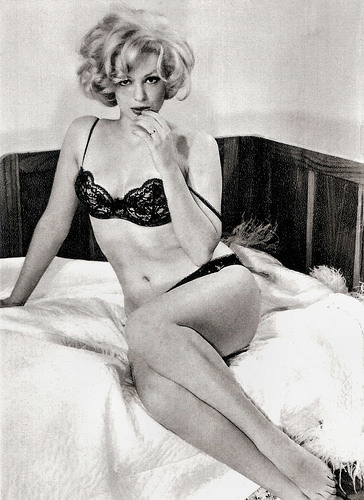
Italian collectors card by La Rotografica Romana. Edito dalla Nat Nuova Alta Tensione.
Sexy femme fatales
Around the mid-1960s, Margaret Lee started to appear in a long line of Eurospy films, where she was frequently cast as the sexy femme fatale. Her appearance changed as she dropped the blonde look and became a brunette instead.
These Eurospy films include Le Tigre se parfume à la dynamite/An Orchid for the Tiger (Claude Chabrol, 1965), Agente 077 dall'oriente con furore/Agent 077 From the Orient with Fury (Sergio Grieco, 1965), Se tutte le donne del mondo/Kiss the Girls and Make Them Die (Henry Levin, 1966) with American TV star Mike Connors, and the French James Bond variation Coplan sauve sa peau/Coplan Saves His Skin (Yves Boisset, 1968) opposite Claudio Brook and Jean Servais .
Lee was also popular on Italian television in the 1960s. She appeared as a showgirl alongside the famous singer Johnny Dorelli . Lee also starred with Dorelli in his film debut Arriva Dorellik/How to Kill 400 Duponts (Steno, 1967).
She was also seen in sexy parts opposite Jean Gabin and Robert Stack in Le soleil des voyous/Action Man (Jean Delannoy, 1967), and with Gian Maria Volonté in Banditi a Milano/The Violent Four (Carlo Lizzani, 1968).
Lee spoke both English and Italian fluently, and from 1966 on she dubbed most of her own films.
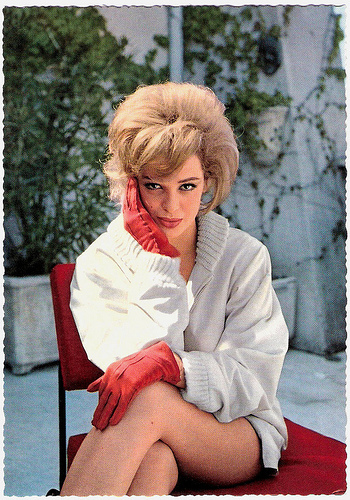
German postcard by Kruger, no. 902/170.
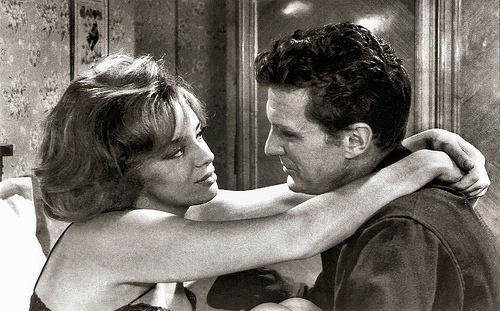
Romanian postcard by Casa Filmului Acin. Publicity still for Le soleil des voyous/Action Man (Jean Delannoy, 1967) with Robert Stack.
Giallo
Margaret Lee caught the eye of international film producer Harry Alan Towers. He gave her wider international recognition by casting her in prominent roles in several of his all-star-cast productions.The first was the British Edgar Wallace mystery Circus of Fear (John Llewellyn Moxey, 1966) starring Christopher Lee . Towers also cast her in the spy-comedy Our Man in Marrakesh (Don Sharp, 1966), the action film Five Golden Dragons (Jeremy Summers, 1967), the thrillers Paroxismus/Venus in Furs (1969) and Il trono di fuoco/The Bloody Judge (1970), both directed by Jesús Franco.
Finally, Lee starred in the Oscar Wilde adaptation Dorian Gray (Massimo Dallamano, 1970) starring Helmut Berger . Lee's co-star in Circus of Fear, Five Golden Dragons and Venus in Furs was the renowned German actor Klaus Kinski , who was also a regular in Harry Alan Towers productions. The pairing of Lee and Kinski proved to be very popular among cinema-goers - especially in Italy - so they would appear in a total of 12 films together. Other interesting films in which Margaret Lee appeared were I Bastardi/Sons of Satan (Duccio Tessari, 1969) - one of the last films of Rita Hayworth , and the Giallo (Italian thriller) Gli assassini sono nostri ospiti/The Killers Are Our Guests (Vincenzo Rigo, 1974) starring Anthony Steffen .
However, with the death of the Spy genre in the late 1960s, Margaret Lee was then often cast in popular Euro-horror flicks. Wikipedia notes: "By the early 1970s, Lee's movie career had descended further and further into exploitation; culminating in Fernando Di Leo's extremely sleazy and violent thriller La bestia uccide a sangue freddo/Slaughter Hotel (1971)."
In 1974 she retired from the film industry and returned to England. In 1982 she came back for two more films, the comedies Sesso e volentieri/Sex As You Like It (Dino Risi, 1982), which reunited her with her old co-star Johnny Dorelli , and Stangata napoletana/Neapolitan Sting (Vittorio Caprioli, 1983) starring Treat Williams. Margaret Lee married in 1963 choreographer/agent Gino Malerba. From this marriage which soon ended in a divorce, she had a son, producer/production manager Roberto Malerba of V for Vendetta (James McTeigue, 2006) and Speed Racer (Andy Wachowski, Lana Wachowski, 2008).
After retiring in England she married again and had another son, production coordinator Damian Anderson of V for Vendetta (James McTeigue, 2006) and Ninja Assassin (James McTeigue, 2009). In 1987, Margaret Lee moved to the Bay Area in California. In 1988 she studied the Stanislavsi 'Method' Acting techniques for a year with Jean Shelton in San Francisco. Later she worked as a stage actress in a small theatre.
Margaret Lee performs an Italo-pop lounge act in the Diabolik parody Arriva Dorellik (1967). Source: Modcinema (YouTube).
Margaret Lee sings the title song in Five Golden Dragons (1967). Source: Filmfan3 (YouTube).
Sources: Les gens du cinema (French), Du dumme Sau – a Kinski Blog, Brian J. Walker (Brian's Drive-in Theater), Sandra Brennan (Allmovie), Wikipedia and .

German postcard by Krüger, no. 902/361. Photo: Georg Michalke.

German postcard by Kruger, no. 902/356. Photo: Georg Michalke.
Blonde, fluffy look
Margaret (sometimes credited as Margareth) Lee was born Margaret Gwendolyn Box in Wolverhampton, England in 1943. Her mother, who lived in wartime London, was evacuated because of the bombing to a family in Wolverhampton in the West Midlands, whom she had never met before. After the bombing ended mother and daughter returned to London, and Margaret grew up there. She was educated at Roan Grammar School in Greenwich and later studied for three years at the Italia Conti Theatre School in London.
Margaret Lee in an interview with the blog Du dumme Sau! : "I wanted to act in the Theatre (never thought of films) and was willing to take any path that might lead me there. I read in The Stage of auditions for showgirls at the famous Moulin Rouge in Paris. I was 17. I wanted to get away from home, and so I auditioned and was taken on. Then almost a year later, a friend told me they were interviewing for small parts in Cleopatra with Elizabeth Taylor in Rome. I auditioned and was accepted. Within two weeks I was in Rome and going to Cinecitta Film Studios each day. In the end, however, many hours of the film were cut, including my appearances."
At the set of Cleopatra (Joseph L. Mankiewicz, 1963), she met Gino Malerba, who worked as an assistant to choreographer Hermes Pan. When the filming of Cleopatra ended he introduced her to an agent, Fillipo Fortini. They both hoped in this way Lee could get work as an actress in Rome and not have to return to London. It worked and Malerba and Lee would later marry.
She made her screen debut in Maciste contro i mostri/Fire Monsters Against the Son of Hercules (Guido Malatesta, 1962) opposite bodybuilder Reg Lewis. With a blonde, fluffy look modelled after Marilyn Monroe , Lee followed it up with a stream of low-budget Peplum spectacles, comedies and thrillers. Some of them are now considered cult films.
Highlights include Gli Imbroglioni/The Swindlers (Lucio Fulci, 1963) with Walter Chiari , the comedy In ginocchio da te/On My Knees For You (Ettore Maria Fizzarotti, 1964) starring singer Gianni Morandi , Questa volta parliamo di uomini/Let's Talk About Men (Lina Wertmüller, 1965) with Nino Manfredi , and Casanova '70 (Mario Monicelli, 1965) with Marcello Mastroianni . She appeared in several comedies and parodies which starred the popular comedic duo Franco Franchi and Ciccio Ingrassia. Few of these films received much (if any) distribution in foreign territories, but they were highly successful in Italy and made Lee a well-known film actress there.

Israelian postcard by Éditions de Luxe, no. 123.

Italian collectors card by La Rotografica Romana. Edito dalla Nat Nuova Alta Tensione.
Sexy femme fatales
Around the mid-1960s, Margaret Lee started to appear in a long line of Eurospy films, where she was frequently cast as the sexy femme fatale. Her appearance changed as she dropped the blonde look and became a brunette instead.
These Eurospy films include Le Tigre se parfume à la dynamite/An Orchid for the Tiger (Claude Chabrol, 1965), Agente 077 dall'oriente con furore/Agent 077 From the Orient with Fury (Sergio Grieco, 1965), Se tutte le donne del mondo/Kiss the Girls and Make Them Die (Henry Levin, 1966) with American TV star Mike Connors, and the French James Bond variation Coplan sauve sa peau/Coplan Saves His Skin (Yves Boisset, 1968) opposite Claudio Brook and Jean Servais .
Lee was also popular on Italian television in the 1960s. She appeared as a showgirl alongside the famous singer Johnny Dorelli . Lee also starred with Dorelli in his film debut Arriva Dorellik/How to Kill 400 Duponts (Steno, 1967).
She was also seen in sexy parts opposite Jean Gabin and Robert Stack in Le soleil des voyous/Action Man (Jean Delannoy, 1967), and with Gian Maria Volonté in Banditi a Milano/The Violent Four (Carlo Lizzani, 1968).
Lee spoke both English and Italian fluently, and from 1966 on she dubbed most of her own films.

German postcard by Kruger, no. 902/170.

Romanian postcard by Casa Filmului Acin. Publicity still for Le soleil des voyous/Action Man (Jean Delannoy, 1967) with Robert Stack.
Giallo
Margaret Lee caught the eye of international film producer Harry Alan Towers. He gave her wider international recognition by casting her in prominent roles in several of his all-star-cast productions.The first was the British Edgar Wallace mystery Circus of Fear (John Llewellyn Moxey, 1966) starring Christopher Lee . Towers also cast her in the spy-comedy Our Man in Marrakesh (Don Sharp, 1966), the action film Five Golden Dragons (Jeremy Summers, 1967), the thrillers Paroxismus/Venus in Furs (1969) and Il trono di fuoco/The Bloody Judge (1970), both directed by Jesús Franco.
Finally, Lee starred in the Oscar Wilde adaptation Dorian Gray (Massimo Dallamano, 1970) starring Helmut Berger . Lee's co-star in Circus of Fear, Five Golden Dragons and Venus in Furs was the renowned German actor Klaus Kinski , who was also a regular in Harry Alan Towers productions. The pairing of Lee and Kinski proved to be very popular among cinema-goers - especially in Italy - so they would appear in a total of 12 films together. Other interesting films in which Margaret Lee appeared were I Bastardi/Sons of Satan (Duccio Tessari, 1969) - one of the last films of Rita Hayworth , and the Giallo (Italian thriller) Gli assassini sono nostri ospiti/The Killers Are Our Guests (Vincenzo Rigo, 1974) starring Anthony Steffen .
However, with the death of the Spy genre in the late 1960s, Margaret Lee was then often cast in popular Euro-horror flicks. Wikipedia notes: "By the early 1970s, Lee's movie career had descended further and further into exploitation; culminating in Fernando Di Leo's extremely sleazy and violent thriller La bestia uccide a sangue freddo/Slaughter Hotel (1971)."
In 1974 she retired from the film industry and returned to England. In 1982 she came back for two more films, the comedies Sesso e volentieri/Sex As You Like It (Dino Risi, 1982), which reunited her with her old co-star Johnny Dorelli , and Stangata napoletana/Neapolitan Sting (Vittorio Caprioli, 1983) starring Treat Williams. Margaret Lee married in 1963 choreographer/agent Gino Malerba. From this marriage which soon ended in a divorce, she had a son, producer/production manager Roberto Malerba of V for Vendetta (James McTeigue, 2006) and Speed Racer (Andy Wachowski, Lana Wachowski, 2008).
After retiring in England she married again and had another son, production coordinator Damian Anderson of V for Vendetta (James McTeigue, 2006) and Ninja Assassin (James McTeigue, 2009). In 1987, Margaret Lee moved to the Bay Area in California. In 1988 she studied the Stanislavsi 'Method' Acting techniques for a year with Jean Shelton in San Francisco. Later she worked as a stage actress in a small theatre.
Margaret Lee performs an Italo-pop lounge act in the Diabolik parody Arriva Dorellik (1967). Source: Modcinema (YouTube).
Margaret Lee sings the title song in Five Golden Dragons (1967). Source: Filmfan3 (YouTube).
Sources: Les gens du cinema (French), Du dumme Sau – a Kinski Blog, Brian J. Walker (Brian's Drive-in Theater), Sandra Brennan (Allmovie), Wikipedia and .
Published on April 26, 2024 22:00
April 25, 2024
Anita Ekberg
Anita Ekberg (1931-2015) was a Swedish-born but naturalised Italian film actress. As Miss Sweden in 1950, she was contracted by Howard Hughes, had a Hollywood career in the 1950s, but got her real breakthrough in Italy. She made film history as the sensual, curvaceous film goddess who dances in the Trevi Fountain in Fellini’s La Dolce Vita (1960). She was also a sexy billboard figure coming to life in Fellini's short film La Tentazioni del Dottor Antonio/The Temptation of Doctor Antonio (1962).
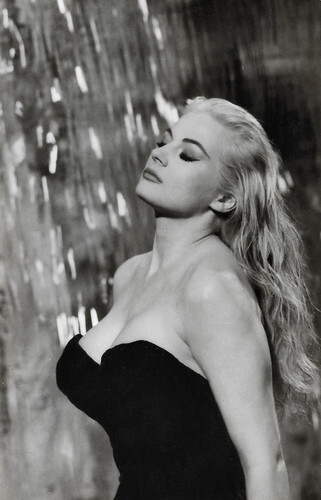
Romanian postcard by Casa Filmului Acin. Anita Ekberg in La Dolce Vita (Federico Fellini, 1960).
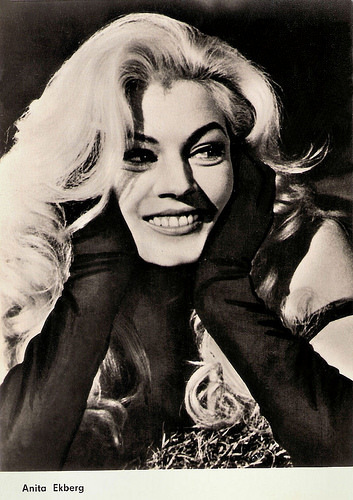
East-German postcard by VEB Progress Film-Vertrieb, Berlin, no. 2391, 1965. Anita Ekberg in Boccaccio '70 (Federico Fellini, 1962).
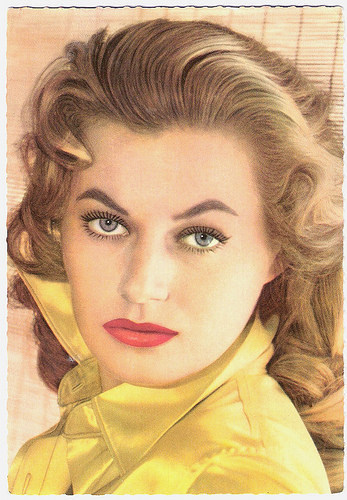
German postcard by ISV, no. F 10.
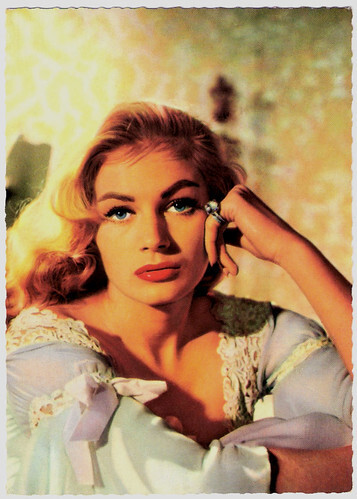
German postcard by ISV, no. D 8. Photo: Pierluigi.
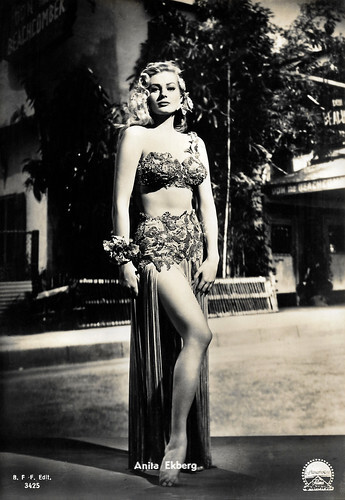
Italian postcard by B.F.F. Edit., no. 3425. Photo: Paramount Films.
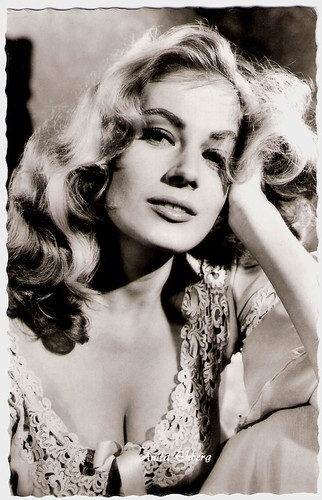
German postcard by Kolibri-Verlag, Minden/Westf., no. 150.
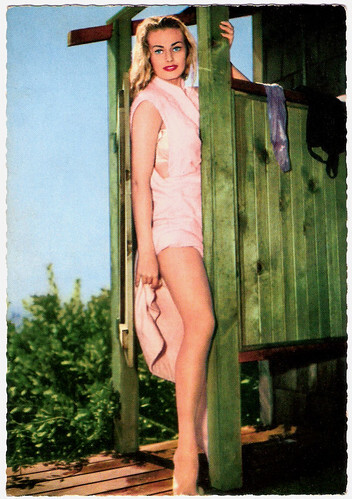
German postcard by ISV, Sort. VI/6.
Miss Sweden
Kerstin Anita Marianne Ekberg was born in Malmö, Sweden in 1931. She grew up with seven brothers and sisters. Having six brothers around surely developed a fierce independent spirit. In her teens, she worked as a fashion model, and in 1951 she was elected Miss Sweden. That year she also debuted in the film journal Terras fönster nr 5/Terra Journal No. 5 (Olle Ekelund, 1951), about the new beauty queen's visit to Stockholm. According to several sources, Ekberg went to the US for the Miss Universe contest, although she did not speak English. She didn't win but did get a modelling contract.
However, Marlene Pilaetein a La Collectionneuse post on the sadly discontinued website L'Encinématheque did extensive research regarding the Miss Universe contests and concluded that Ekberg was not in a Miss Universe contest: "The problem was that the first Miss Universe of the 'modern' era was crowned in June 1952, and Sweden's representative was a certain Anne Marie Tistler. We prefer to rely on Life magazine of 8 October 1951, which does indeed mention Anita Ekberg's presence on American soil, but as guest of honour at the 'Miss America' contest. It seems that this was the real reason for the young woman's arrival in the U.S. No mention was made of Miss Universe in this article.'In February 1952, Anita Ekberg won second place in the European Miss Casino beauty contest in Amsterdam. The winner was the English contestant, Judy Breen. Miss Nederland, Betty van Proosdij, came in third place.
Film mogul Howard Hughes gave her a contract with RKO and an American magazine compared her to another Hughes discovery: "Anita Ekberg: the girl who makes Jane Russell look like a boy". However, the contract didn't lead to films. Anita herself later claimed that Hughes wanted to marry her. Instead the voluptuous, husky-voiced blonde started making films for Universal. Her American debut was as a Venusian guard in Abbott and Costello Go to Mars (Charles Lamont, 1953). This was soon followed by The Golden Blade (Nathan Juran, 1953) starring Rock Hudson . These were small roles that only required her to look beautiful. She was nicknamed ‘The Iceberg’ - a play on her name and on her cool, quite mysterious demeanour.
While at Universal, Anita Ekberg quickly became one of Hollywood’s hot starlets thanks to her sexy photos, which were widely published in the press. She caught the hearts of many famous men including Tyrone Power , Errol Flynn , Frank Sinatra and Gary Cooper . Legendary director and photographer Russ Meyer called her 'the most beautiful woman he ever photographed'. He said her 40D bust line was 'the most ample in A list Hollywood history, dwarfing rivals like Jayne Mansfield '. Marlene Pilaete: "Now that silicone prostheses are commonplace, I think it's important to point out that it was Mother Nature alone who endowed Anita Ekberg with her good looks. But it would be unfair to reduce her to a pair of breasts. That would be to forget a face with regular features, a well-defined profile, a dazzling smile and an obvious photogenic talent."
Soon she became a major pin-up girl for the new type of men's magazine such as Playboy that proliferated in the 1950s. Ekberg also knew how to play the Hollywood tabloids and gossip columnists, creating stunts that she hoped would translate into film roles. Famously, she admitted that an incident where her dress burst open in the lobby of London's Berkeley Hotel was pre-arranged with a photographer. Her two marriages also gave her a lot of attention from the press. She married and divorced British actor Anthony Steel (1956-1959) and actor Rik Van Nutter (1963-1975). She reportedly had a three-year affair with the late Fiat chairman Gianni Agnelli. The press also loved her saucy quotes, like: "I'm very proud of my breasts, as every woman should be. It's not cellular obesity. It's womanliness."
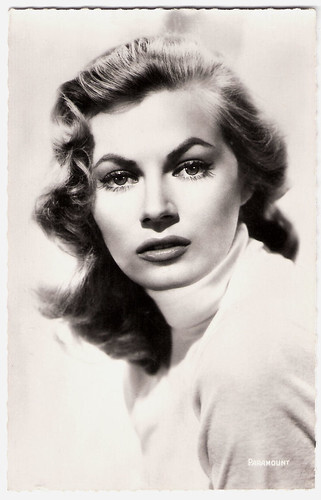
French postcard by Editions du Globe (EDUG), no. 521. Photo: Paramount.
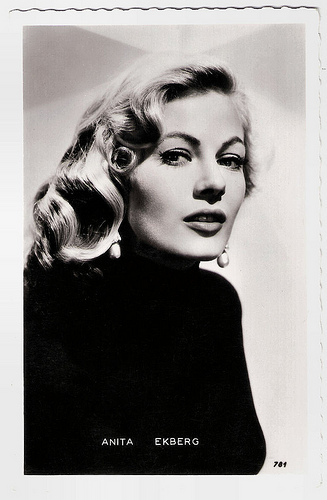
French postcard by Editions P.I., Paris, no. 781. Photo: Paramount.
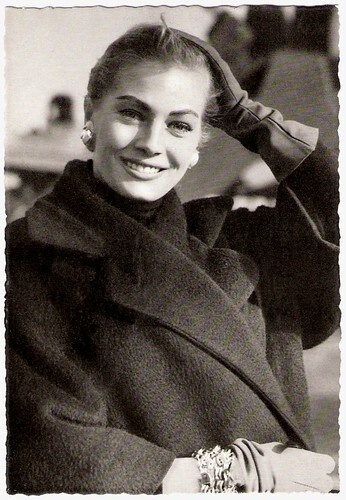
German postcard by WS-Druck, Wanne-Eickel, no. 203. Photo: dpa.
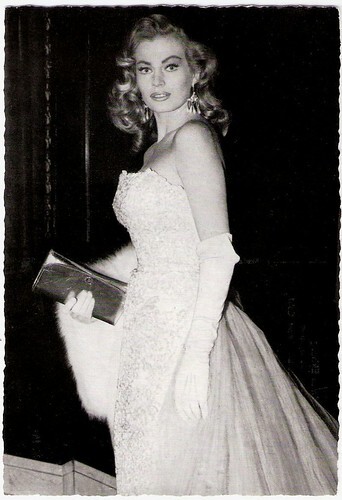
German postcard by WS-Druck, Wanne-Eickel, no. 181. Photo: dpa.
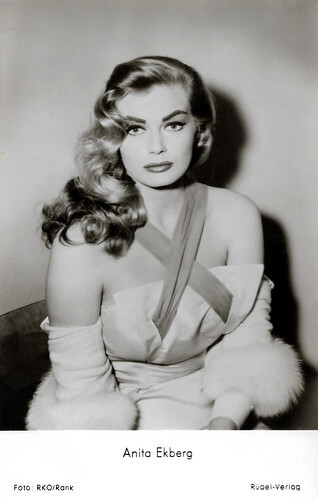
West German postcard by Rüdel-Verlag, Hamburg-Bergedorf, no. 3058. Photo: RKO / Rank. Anita Ekberg in Back from Eternity (John Farrow, 1956).
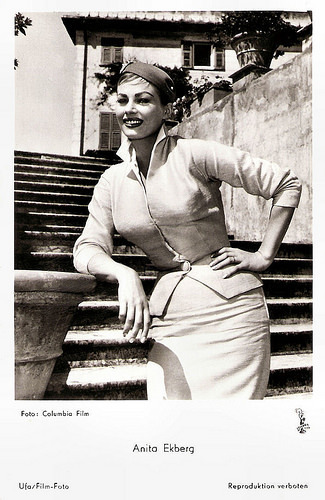
German postcard by Ufa, Berlin-Tempelhof, no. FK 3590. Photo: Columbia Film. Publicity still for Interpol (John Gilling, 1957).
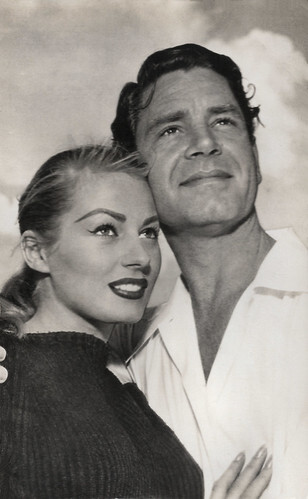
Spanish postcard by Archivo Bermejo, no. 5922. Sent by mail in 1958. Anita Ekberg and Anthony Steel .
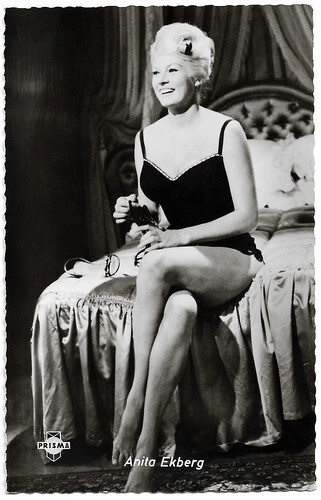
West German postcard by Kolibri-Verlag G.m.b.H., Minden/Westf., no. 1503. Photo: Prisma-Film. Anita Ekberg in Anonima cocottes/Little Girls and High Finance (Camillo Mastrocinque, 1960). The German title was Rosemarie G.M.B.H.
Foil for sight gags
Anita Ekberg would get several offers from other studios. Bob Hope joked that her parents had received the Nobel Prize for architecture when he was touring with her and William Holden to entertain US troops in 1954. The tour led her to a contract with John Wayne 's Batjac Productions. Wayne cast her in Blood Alley (William A. Wellman, 1955), a small role where Ekberg's features and appearance were Orientalised to play a Chinese woman. The role earned her a Golden Globe in February 1956 for the most promising newcomer of 1955, ex aequo with Victoria Shaw and Dana Wynter.
Her career as a star was now launched. Paramount Pictures cast her in the funny comedies Artists and Models (Frank Tashlin, 1955) and Hollywood or Bust (Frank Tashlin, 1956), starring Dean Martin and Jerry Lewis . These films showed off her stunning body and used her as a foil for many of the director's clever sight gags.
Ekberg went to Rome to make War and Peace (King Vidor, 1956) co-starring Audrey Hepburn . According to a newspaper of the time, the visit allowed her to cause a sensation with the Roman male sex. RKO gave Ekberg the female lead in Back from Eternity (John Farrow, 1956), co-starring with Robert Ryan and Rod Steiger. Ekberg was perfectly adequate in her cardboard role. With a good director and a worthwhile part, she might have something to offer.
In the British production Zarak (Terence Young, 1956) starring Victor Mature and Michael Wilding , her sexy harem-girl dance raised many eyebrows and blood pressure. With Bob Hope, she made two minor comedies, Paris Holiday (Gerd Oswald, 1958) and Call Me Bwana (Gordon Douglas, 1963).
One of her better films of this period was the Film Noir Screaming Mimi (Gerd Oswald, 1958). At IMDb , reviewer Lazarillo calls it "the missing link between American Film Noir and the Suspense and Horror films that would become so popular in continental Europe over the next two decades (i.e. the German 'Krimis', the Italian 'Gialli', the Horror films of Bava and Argento). It's technically a late-period Film Noir, but rather than having the traditional pessimistic tone and hard-boiled, voice-over narrative, it is completely off-the-wall and chock-full of the suggested depravity and lurid psycho-babble that would characterise the later European films. Interestingly, it was apparently based on the same Fredric Brown novel as Dario Argento's Bird with Crystal Plumage."
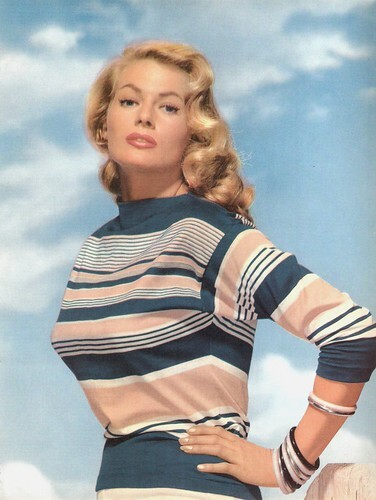
Vintage postcard.
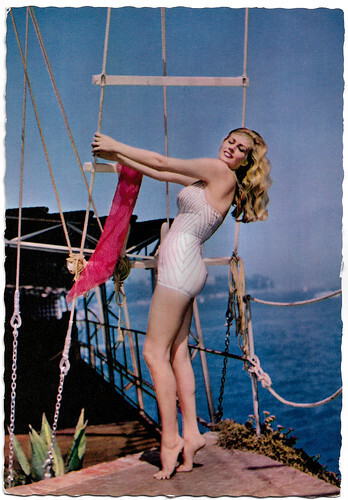
French postcard, no. 101.
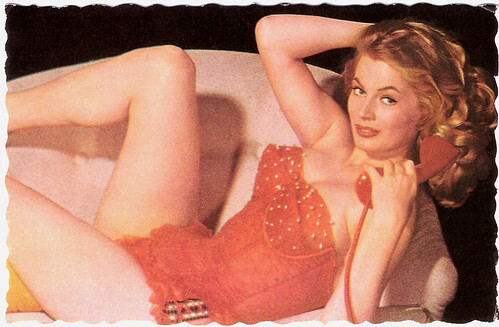
French postcard by De Marchi Frères, Marseille.
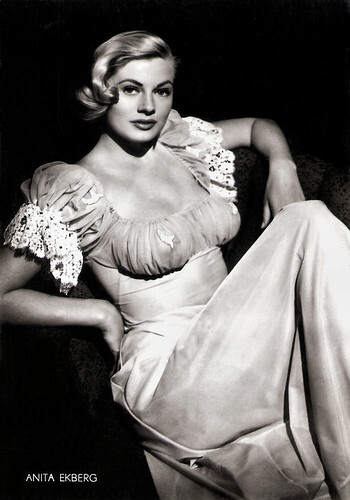
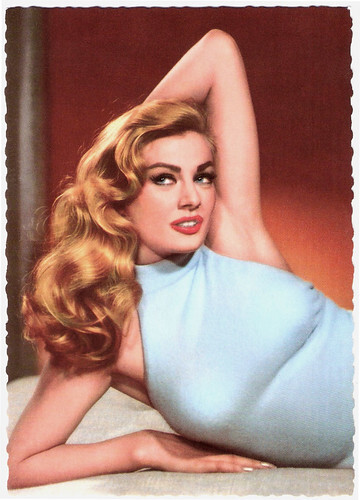
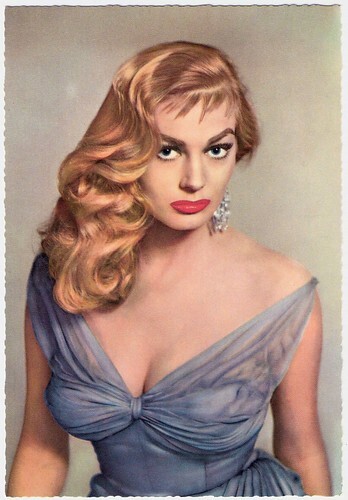
German postcard by ISV, no. H 23.
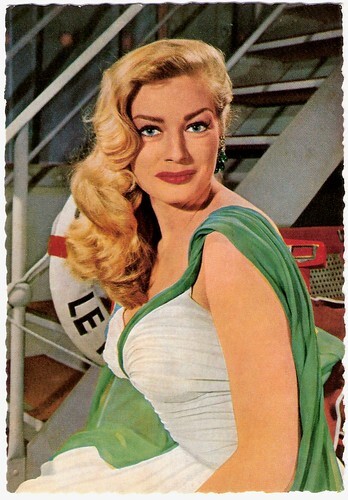
German postcard by WS-Druck, Wanne-Eickel. Photo: Klaus Collignon.
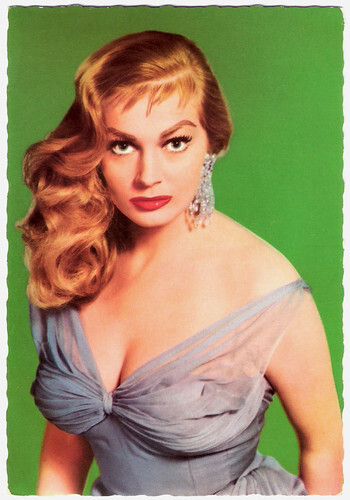
French postcard by EDUG, no. 151.
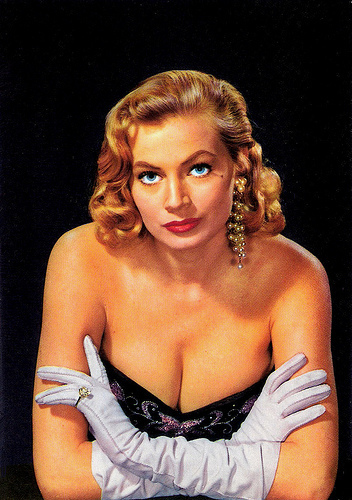
Italian postcard by Rotalcolor, Milano, no. N. 51.
The sweet life
In 1960 Anita Ekberg found herself again in Rome for her greatest role. She played the unattainable ‘dream woman’ Sylvia opposite Marcello Mastroianni in Federico Fellini 's La Dolce Vita/The Sweet Life (1960). La Dolce Vita was a sensational success, and Ekberg's uninhibited cavorting in Rome's Trevi Fountain remains one of the most memorable screen images ever captured. Marlene Pilaete: "The actress and Italy were made for each other. It's funny to note that it was a Swede who perfectly embodied the madness of Roman nightlife in the 50s and 60s, much more so than the much wiser Sophia Loren , Gina Lollobrigida or Claudia Cardinale . It's precisely this slightly exaggerated side that appeals to me about Anita Ekberg."
Thus began a period when Ekberg would work almost exclusively in Europe. La Dolce Vita was followed by another memorable role for Fellini in his segment La Tentazioni del Dottor Antonio/The Temptation of Doctor Antonio of the anthology film Boccaccio '70 (1962). She plays a gigantic voluptuous lady on a billboard poster, promoting drinking milk and attracting huge crowds. At night she comes to live and pesters the little censor, played by Peppino De Filippo . Fellini would later call her back for two more films: I Pagliacci/I Clowns (Federico Fellini, 1971), and Intervista (Federico Fellini, 1987).
In 1964 she returned to Sweden to appear in Bo Widerberg's Kärlek 65/Love 65 (1965), but she cancelled her appearance and called the acclaimed director ‘an amateur’. In 1967 she co-starred with Shirley MacLaine in a segment of Vittorio de Sica ’s Woman Times Seven (1967). For much of the 1960s though, she was trapped in substandard genre fare and lame comedies. During the 1970s the roles became less frequent. Fellini shot I Pagliacci/I Clowns for RAI. It was shown on television on Christmas Day 1970 before being released in cinemas. In 1982, at 50, she posed for glamour photos. Twenty-seven years after La Dolce Vita, she made a marvellous comeback with Fellini's film autobiography, Intervista (Federico Fellini, 1987), where she played herself in a reunion scene with Mastroianni and watched film clips of herself during her heydays. In 1995 Empire magazine chose her as one of the 100 Sexiest Stars in film history (#98).
While she remained active in films into the 1990s, the roles were hardly memorable. Exceptions came with her portrayal of an elderly restaurant owner who is killed in a gas explosion in Bámbola/Doll (Bigas Luna, 1996) featuring Valeria Marini, and her final role as an ageing, flamboyant opera who was strangled to death by a dwarf with whom she had had an affair in Le nain rouge/The Red Dwarf (Yvan Lemoine, 1998). Still blonde, but a bit heavier, Ekberg was able to project the requisite sensuality and diva-like behaviour resulting in a full-bodied performance that ranked among her best. Her last role in a TV series was in Il bello delle donne/The Beautiful One of the Women (2002) starring Stefania Sandrelli.
Since the early 1950s, Anita Ekberg never lived in Sweden and rarely visited the country. She welcomed Swedish journalists into her house outside Rome, and in 2005 appeared in the popular radio program 'Sommar', talking about her life. She stated in an interview that she would not move back to Sweden until she died when she would be buried there. In 2015, Anita Ekberg died at the clinic San Raffaele in Rocca di Papa, Italy. Her death was caused by complications from a long-time illness. She was 83. Marlene Pilaete: "I've been to Rome a few times and each time I pass the Trevi Fountain. Seeing the crowds of people gathered in front of this monument, I think to myself that the charities that benefit from the coins thrown away by tourists must thank Anita Ekberg and Fellini every day. They filmed one of the most legendary scenes of the Seventh Art and did a lot for the reputation of the place. Let's leave her with the final word, in an interview from 2011: 'I have no regrets. I loved it, I cried, I was crazy with happiness. I won and I lost...' That sounds just like her."
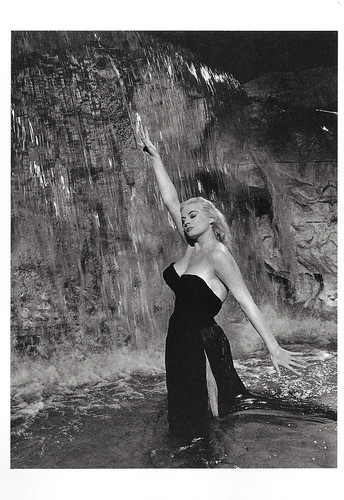
French postcard in the Collection Magie Noire by Editions Hazan, Paris, no. 6323. Anita Ekberg in La dolce vita (Federico Fellini, 1960).
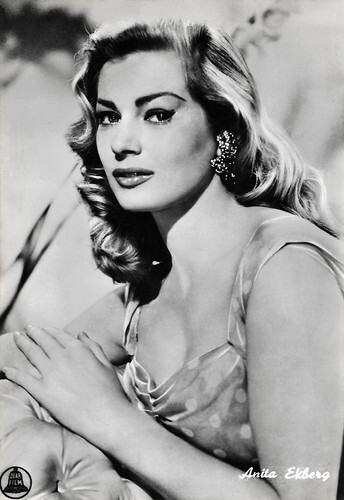
Italian postcard by Bromofoto, Milano. Sent by mail in 1962. Photo: Dear Film.

Italian postcard, no. 445.
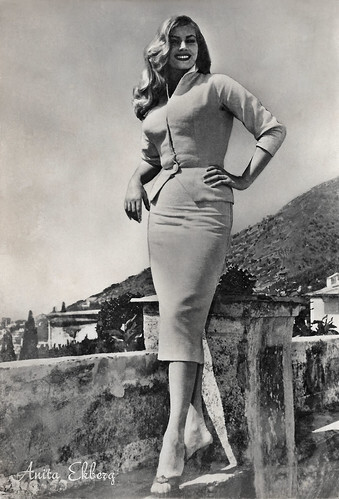
Italian postcard by Rotalfoto, Milano, no. 720.
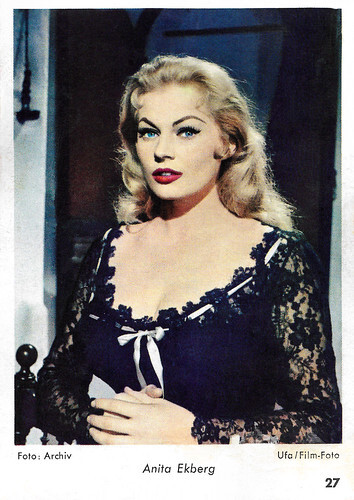
German collectors card by Ufa/Film-Foto, Berlin, no. 27. Photo: Anita Ekberg in Le tre eccetera del colonnello/Three Etc.'s and the Colonel (Claude Boissol, 1960).
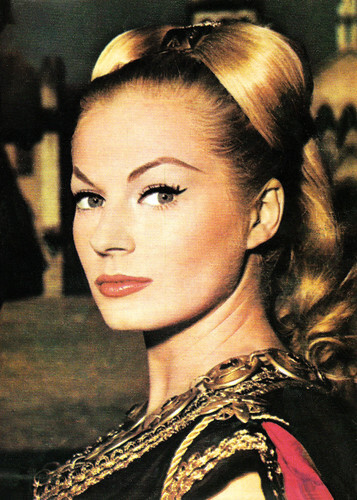
Romanian postcard by Casa Filmului Acin, no. 413. Anita Ekberg in I mongoli/The Mongols (André De Toth, Leopoldo Savona, Riccardo Freda, 1961).
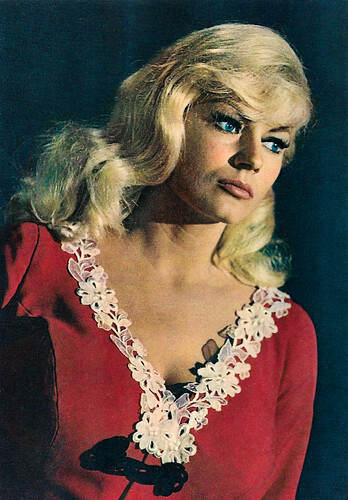
Italian postcard by Rotalfoto, Milano, no. N. 170.
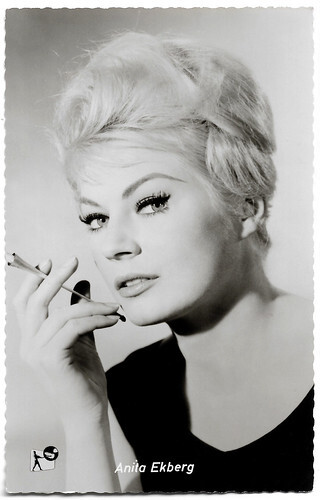
German postcard by Kolibri Verlag, Minden, no. 1960. Photo: Rank Film. Anita Ekberg in Call Me Bwana (Gordon Douglas, 1963).
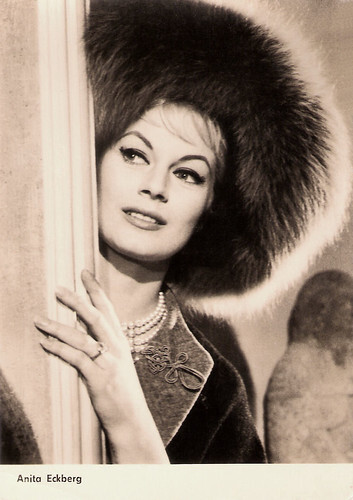
East-German postcard by VEB Progress Film-vertrieb, Berlin, no. 3171, 1968. Retail price: 0,20 M. Photo: Pierluigi.
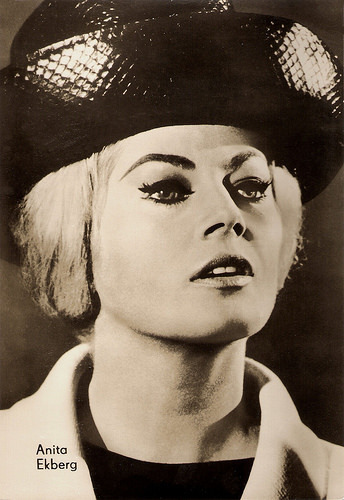
Big East-German card by VEB Progress Film-Vertrieb, Berlin, no. 262/69.
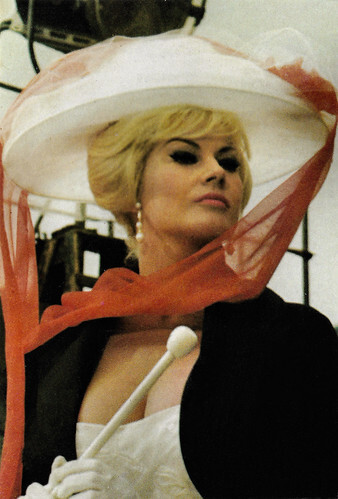
Spanish postcard by Postal Oscarcolor, no. 0902-65. Photo: Anita Ekberg in Woman Times Seven (Vittorio De Sica, 1967).
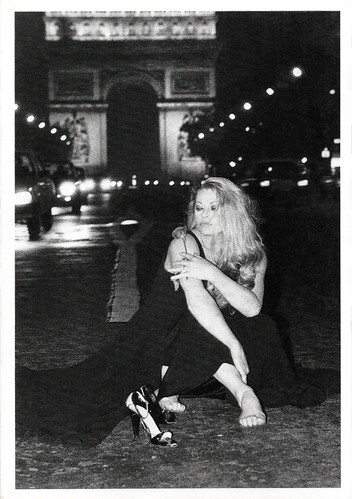
French postcard by Collection City Z. Paris, no. 20. Photo: Michel Giniès.
Trailer Artists and Models (1955). Source: Arnold Zieffel (YouTube).
Anita does a sexy dance in the thriller Screaming Mimi 1958). Source: Bachflat (YouTube).
Trailer Intervista (1987). Source: Buen Cine Dvd (YouTube).
Sources: Hal Erickson (AllMovie), Marlene Pilaete (L'Encinématheque - now defunct), (IMDb), Java’s Bachelor Pad, TCM (page now defunct), Wikipedia, and .

Romanian postcard by Casa Filmului Acin. Anita Ekberg in La Dolce Vita (Federico Fellini, 1960).

East-German postcard by VEB Progress Film-Vertrieb, Berlin, no. 2391, 1965. Anita Ekberg in Boccaccio '70 (Federico Fellini, 1962).

German postcard by ISV, no. F 10.

German postcard by ISV, no. D 8. Photo: Pierluigi.

Italian postcard by B.F.F. Edit., no. 3425. Photo: Paramount Films.

German postcard by Kolibri-Verlag, Minden/Westf., no. 150.

German postcard by ISV, Sort. VI/6.
Miss Sweden
Kerstin Anita Marianne Ekberg was born in Malmö, Sweden in 1931. She grew up with seven brothers and sisters. Having six brothers around surely developed a fierce independent spirit. In her teens, she worked as a fashion model, and in 1951 she was elected Miss Sweden. That year she also debuted in the film journal Terras fönster nr 5/Terra Journal No. 5 (Olle Ekelund, 1951), about the new beauty queen's visit to Stockholm. According to several sources, Ekberg went to the US for the Miss Universe contest, although she did not speak English. She didn't win but did get a modelling contract.
However, Marlene Pilaetein a La Collectionneuse post on the sadly discontinued website L'Encinématheque did extensive research regarding the Miss Universe contests and concluded that Ekberg was not in a Miss Universe contest: "The problem was that the first Miss Universe of the 'modern' era was crowned in June 1952, and Sweden's representative was a certain Anne Marie Tistler. We prefer to rely on Life magazine of 8 October 1951, which does indeed mention Anita Ekberg's presence on American soil, but as guest of honour at the 'Miss America' contest. It seems that this was the real reason for the young woman's arrival in the U.S. No mention was made of Miss Universe in this article.'In February 1952, Anita Ekberg won second place in the European Miss Casino beauty contest in Amsterdam. The winner was the English contestant, Judy Breen. Miss Nederland, Betty van Proosdij, came in third place.
Film mogul Howard Hughes gave her a contract with RKO and an American magazine compared her to another Hughes discovery: "Anita Ekberg: the girl who makes Jane Russell look like a boy". However, the contract didn't lead to films. Anita herself later claimed that Hughes wanted to marry her. Instead the voluptuous, husky-voiced blonde started making films for Universal. Her American debut was as a Venusian guard in Abbott and Costello Go to Mars (Charles Lamont, 1953). This was soon followed by The Golden Blade (Nathan Juran, 1953) starring Rock Hudson . These were small roles that only required her to look beautiful. She was nicknamed ‘The Iceberg’ - a play on her name and on her cool, quite mysterious demeanour.
While at Universal, Anita Ekberg quickly became one of Hollywood’s hot starlets thanks to her sexy photos, which were widely published in the press. She caught the hearts of many famous men including Tyrone Power , Errol Flynn , Frank Sinatra and Gary Cooper . Legendary director and photographer Russ Meyer called her 'the most beautiful woman he ever photographed'. He said her 40D bust line was 'the most ample in A list Hollywood history, dwarfing rivals like Jayne Mansfield '. Marlene Pilaete: "Now that silicone prostheses are commonplace, I think it's important to point out that it was Mother Nature alone who endowed Anita Ekberg with her good looks. But it would be unfair to reduce her to a pair of breasts. That would be to forget a face with regular features, a well-defined profile, a dazzling smile and an obvious photogenic talent."
Soon she became a major pin-up girl for the new type of men's magazine such as Playboy that proliferated in the 1950s. Ekberg also knew how to play the Hollywood tabloids and gossip columnists, creating stunts that she hoped would translate into film roles. Famously, she admitted that an incident where her dress burst open in the lobby of London's Berkeley Hotel was pre-arranged with a photographer. Her two marriages also gave her a lot of attention from the press. She married and divorced British actor Anthony Steel (1956-1959) and actor Rik Van Nutter (1963-1975). She reportedly had a three-year affair with the late Fiat chairman Gianni Agnelli. The press also loved her saucy quotes, like: "I'm very proud of my breasts, as every woman should be. It's not cellular obesity. It's womanliness."

French postcard by Editions du Globe (EDUG), no. 521. Photo: Paramount.

French postcard by Editions P.I., Paris, no. 781. Photo: Paramount.

German postcard by WS-Druck, Wanne-Eickel, no. 203. Photo: dpa.

German postcard by WS-Druck, Wanne-Eickel, no. 181. Photo: dpa.

West German postcard by Rüdel-Verlag, Hamburg-Bergedorf, no. 3058. Photo: RKO / Rank. Anita Ekberg in Back from Eternity (John Farrow, 1956).

German postcard by Ufa, Berlin-Tempelhof, no. FK 3590. Photo: Columbia Film. Publicity still for Interpol (John Gilling, 1957).

Spanish postcard by Archivo Bermejo, no. 5922. Sent by mail in 1958. Anita Ekberg and Anthony Steel .

West German postcard by Kolibri-Verlag G.m.b.H., Minden/Westf., no. 1503. Photo: Prisma-Film. Anita Ekberg in Anonima cocottes/Little Girls and High Finance (Camillo Mastrocinque, 1960). The German title was Rosemarie G.M.B.H.
Foil for sight gags
Anita Ekberg would get several offers from other studios. Bob Hope joked that her parents had received the Nobel Prize for architecture when he was touring with her and William Holden to entertain US troops in 1954. The tour led her to a contract with John Wayne 's Batjac Productions. Wayne cast her in Blood Alley (William A. Wellman, 1955), a small role where Ekberg's features and appearance were Orientalised to play a Chinese woman. The role earned her a Golden Globe in February 1956 for the most promising newcomer of 1955, ex aequo with Victoria Shaw and Dana Wynter.
Her career as a star was now launched. Paramount Pictures cast her in the funny comedies Artists and Models (Frank Tashlin, 1955) and Hollywood or Bust (Frank Tashlin, 1956), starring Dean Martin and Jerry Lewis . These films showed off her stunning body and used her as a foil for many of the director's clever sight gags.
Ekberg went to Rome to make War and Peace (King Vidor, 1956) co-starring Audrey Hepburn . According to a newspaper of the time, the visit allowed her to cause a sensation with the Roman male sex. RKO gave Ekberg the female lead in Back from Eternity (John Farrow, 1956), co-starring with Robert Ryan and Rod Steiger. Ekberg was perfectly adequate in her cardboard role. With a good director and a worthwhile part, she might have something to offer.
In the British production Zarak (Terence Young, 1956) starring Victor Mature and Michael Wilding , her sexy harem-girl dance raised many eyebrows and blood pressure. With Bob Hope, she made two minor comedies, Paris Holiday (Gerd Oswald, 1958) and Call Me Bwana (Gordon Douglas, 1963).
One of her better films of this period was the Film Noir Screaming Mimi (Gerd Oswald, 1958). At IMDb , reviewer Lazarillo calls it "the missing link between American Film Noir and the Suspense and Horror films that would become so popular in continental Europe over the next two decades (i.e. the German 'Krimis', the Italian 'Gialli', the Horror films of Bava and Argento). It's technically a late-period Film Noir, but rather than having the traditional pessimistic tone and hard-boiled, voice-over narrative, it is completely off-the-wall and chock-full of the suggested depravity and lurid psycho-babble that would characterise the later European films. Interestingly, it was apparently based on the same Fredric Brown novel as Dario Argento's Bird with Crystal Plumage."

Vintage postcard.

French postcard, no. 101.

French postcard by De Marchi Frères, Marseille.



German postcard by ISV, no. H 23.

German postcard by WS-Druck, Wanne-Eickel. Photo: Klaus Collignon.

French postcard by EDUG, no. 151.

Italian postcard by Rotalcolor, Milano, no. N. 51.
The sweet life
In 1960 Anita Ekberg found herself again in Rome for her greatest role. She played the unattainable ‘dream woman’ Sylvia opposite Marcello Mastroianni in Federico Fellini 's La Dolce Vita/The Sweet Life (1960). La Dolce Vita was a sensational success, and Ekberg's uninhibited cavorting in Rome's Trevi Fountain remains one of the most memorable screen images ever captured. Marlene Pilaete: "The actress and Italy were made for each other. It's funny to note that it was a Swede who perfectly embodied the madness of Roman nightlife in the 50s and 60s, much more so than the much wiser Sophia Loren , Gina Lollobrigida or Claudia Cardinale . It's precisely this slightly exaggerated side that appeals to me about Anita Ekberg."
Thus began a period when Ekberg would work almost exclusively in Europe. La Dolce Vita was followed by another memorable role for Fellini in his segment La Tentazioni del Dottor Antonio/The Temptation of Doctor Antonio of the anthology film Boccaccio '70 (1962). She plays a gigantic voluptuous lady on a billboard poster, promoting drinking milk and attracting huge crowds. At night she comes to live and pesters the little censor, played by Peppino De Filippo . Fellini would later call her back for two more films: I Pagliacci/I Clowns (Federico Fellini, 1971), and Intervista (Federico Fellini, 1987).
In 1964 she returned to Sweden to appear in Bo Widerberg's Kärlek 65/Love 65 (1965), but she cancelled her appearance and called the acclaimed director ‘an amateur’. In 1967 she co-starred with Shirley MacLaine in a segment of Vittorio de Sica ’s Woman Times Seven (1967). For much of the 1960s though, she was trapped in substandard genre fare and lame comedies. During the 1970s the roles became less frequent. Fellini shot I Pagliacci/I Clowns for RAI. It was shown on television on Christmas Day 1970 before being released in cinemas. In 1982, at 50, she posed for glamour photos. Twenty-seven years after La Dolce Vita, she made a marvellous comeback with Fellini's film autobiography, Intervista (Federico Fellini, 1987), where she played herself in a reunion scene with Mastroianni and watched film clips of herself during her heydays. In 1995 Empire magazine chose her as one of the 100 Sexiest Stars in film history (#98).
While she remained active in films into the 1990s, the roles were hardly memorable. Exceptions came with her portrayal of an elderly restaurant owner who is killed in a gas explosion in Bámbola/Doll (Bigas Luna, 1996) featuring Valeria Marini, and her final role as an ageing, flamboyant opera who was strangled to death by a dwarf with whom she had had an affair in Le nain rouge/The Red Dwarf (Yvan Lemoine, 1998). Still blonde, but a bit heavier, Ekberg was able to project the requisite sensuality and diva-like behaviour resulting in a full-bodied performance that ranked among her best. Her last role in a TV series was in Il bello delle donne/The Beautiful One of the Women (2002) starring Stefania Sandrelli.
Since the early 1950s, Anita Ekberg never lived in Sweden and rarely visited the country. She welcomed Swedish journalists into her house outside Rome, and in 2005 appeared in the popular radio program 'Sommar', talking about her life. She stated in an interview that she would not move back to Sweden until she died when she would be buried there. In 2015, Anita Ekberg died at the clinic San Raffaele in Rocca di Papa, Italy. Her death was caused by complications from a long-time illness. She was 83. Marlene Pilaete: "I've been to Rome a few times and each time I pass the Trevi Fountain. Seeing the crowds of people gathered in front of this monument, I think to myself that the charities that benefit from the coins thrown away by tourists must thank Anita Ekberg and Fellini every day. They filmed one of the most legendary scenes of the Seventh Art and did a lot for the reputation of the place. Let's leave her with the final word, in an interview from 2011: 'I have no regrets. I loved it, I cried, I was crazy with happiness. I won and I lost...' That sounds just like her."

French postcard in the Collection Magie Noire by Editions Hazan, Paris, no. 6323. Anita Ekberg in La dolce vita (Federico Fellini, 1960).

Italian postcard by Bromofoto, Milano. Sent by mail in 1962. Photo: Dear Film.

Italian postcard, no. 445.

Italian postcard by Rotalfoto, Milano, no. 720.

German collectors card by Ufa/Film-Foto, Berlin, no. 27. Photo: Anita Ekberg in Le tre eccetera del colonnello/Three Etc.'s and the Colonel (Claude Boissol, 1960).

Romanian postcard by Casa Filmului Acin, no. 413. Anita Ekberg in I mongoli/The Mongols (André De Toth, Leopoldo Savona, Riccardo Freda, 1961).

Italian postcard by Rotalfoto, Milano, no. N. 170.

German postcard by Kolibri Verlag, Minden, no. 1960. Photo: Rank Film. Anita Ekberg in Call Me Bwana (Gordon Douglas, 1963).

East-German postcard by VEB Progress Film-vertrieb, Berlin, no. 3171, 1968. Retail price: 0,20 M. Photo: Pierluigi.

Big East-German card by VEB Progress Film-Vertrieb, Berlin, no. 262/69.

Spanish postcard by Postal Oscarcolor, no. 0902-65. Photo: Anita Ekberg in Woman Times Seven (Vittorio De Sica, 1967).

French postcard by Collection City Z. Paris, no. 20. Photo: Michel Giniès.
Trailer Artists and Models (1955). Source: Arnold Zieffel (YouTube).
Anita does a sexy dance in the thriller Screaming Mimi 1958). Source: Bachflat (YouTube).
Trailer Intervista (1987). Source: Buen Cine Dvd (YouTube).
Sources: Hal Erickson (AllMovie), Marlene Pilaete (L'Encinématheque - now defunct), (IMDb), Java’s Bachelor Pad, TCM (page now defunct), Wikipedia, and .
Published on April 25, 2024 22:00
April 24, 2024
La guerre des boutons (1962)
The French film La guerre des boutons/The War of the Buttons (Yves Robert, 1962) is based on the popular children's book (1912) by Louis Pergaud. It is about an escalating war between boys from two neighbouring French villages. In France, it was the most successful French film of 1962. The film was only beaten by The Longest Day at the French box office.
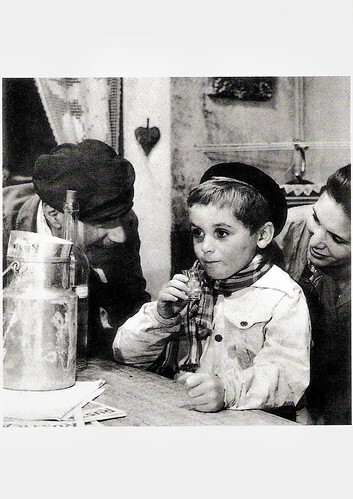
French postcard by Editions La Malibran, Paris, in the Collection Cinéma, no. CF 70. Photo: Martin Lartigue as Petit Gibus in La guerre des boutons/The War of the Buttons (Yves Robert, 1962).
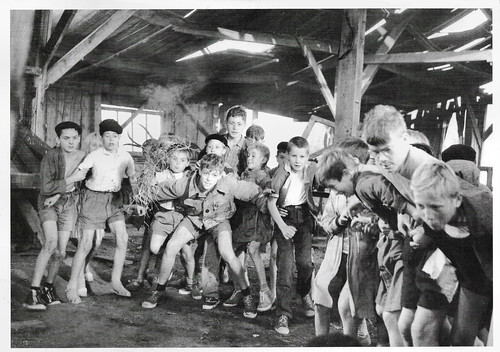
Big French postcard by Les Cinemas Independants Parisiennes, Paris. Photo: publicity still for La guerre des boutons/The War of the Buttons (Yves Robert, 1962).
This calls for revenge
La guerre des boutons/The War of the Buttons (Yves Robert, 1962) is based on 'La Guerre des boutons', a novel by Louis Pergaud (1882–1915), who was killed in action in World War I. His works portray a fervent anti-militarism.
At the beginning of a new school year, it is customary for the children of the village of Longeverne and the children of the neighbouring village of Velrans to clash. The children then fight a real war. The boys from Longeverne are angry with the boys from the neighbouring village of Velrans because they have snatched away all their customers by selling tuberculosis stamps.
This calls for revenge, so the boys from Longeverne, led by their leader Lebrac, go to war against the boys from Velrans. When the boys from Longeverne take a prisoner during the battle, Lebrac comes up to dishonour the prisoner. He cuts all the buttons off his clothes so that he has to walk home with his clothes in tatters.
During the boys' next battle, Lebrac is captured again and stripped of his buttons. When he returns home with his clothes torn, his brutal father beats him up for it. But Lebrac is used to being beaten by his father and does not let this stop him from playing war games.
His new plan is to go into battle naked to avoid dishonour during a battle. And so the boys from Longeverne fight naked against the boys from Velrans. Although they win the battle, they can't celebrate their victory because it gives them colds. So Lebrac comes up with a new ruse.
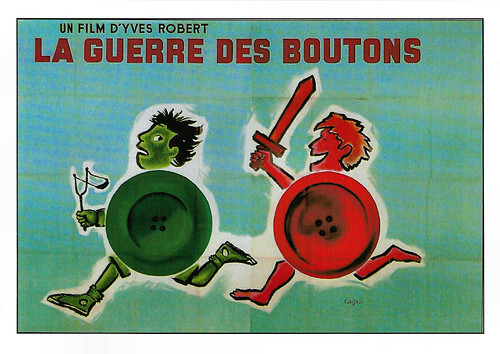
French postcard by Carterie artistique et cinématographique, Pont du Casse in the Encyclopédie du Cinéma / A.D.A.G.P, Paris, no. EDC 1859. Poster illustration: Raymond Savignac. Poster for La guerre des boutons/The War of the Buttons (Yves Robert, 1962).
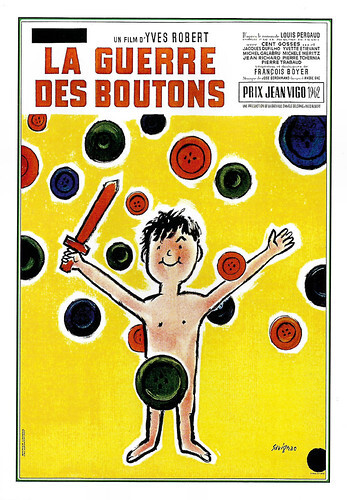
French postcard by Carterie artistique et cinématographique, Pont du Casse in the Encyclopédie du Cinéma / A.D.A.G.P, Paris, no. EDC 3177. Poster illustration: Raymond Savignac. Poster for La guerre des boutons/The War of the Buttons (Yves Robert, 1962).
Anyone who watches the movie will love him
Yves Robert had previously worked mainly as an actor and gained recognition as a director with this film. He remained largely faithful to Louis Pergaud's children's book but moved the plot - set at the beginning of the 20th century - to the present day.
La guerre des boutons/The War of the Buttons (Yves Robert, 1962) stars young and largely untrained actors including André Treton as Lebrac, Michel Isella as l'Aztec and Martin Lartigue as Petit Gibus. Petit Gibus's line of dialogue - uttered in frustration - 'Si j'aurais su, j'aurais pas v'nu' ("If I woulda known, I wouldn'ta come), with its incorrect grammar (the correct form should be: "Si j'avais su, je ne serais pas venu") has become a familiar tagline in France (the line was not in the original novel).
DB DuMonteil at IMDb : "Yves Robert transposed the action to the rural sixties. He gathered lots and lots of children whom he directed masterfully. "Magna cum laude", first class honours, for young Petit Gibus! Anyone who watches the movie will love him: he's so funny when he gets drunk! Shot in black and white, the film will remind you of your schooldays."
La guerre des boutons/The War of the Buttons (1962) won France's Prix Jean Vigo. There have been several film adaptations. The first, directed by Jacques Daroy, was released in 1936. The film was remade in Ireland in 1994 as War of the Buttons, in an Irish setting. In 2011, two different film adaptations were released in French cinemas at the same time to mark the upcoming 100th anniversary of the novel.
In 2018, a board game of the same name was released using the book and film as a basis. Andreas Steding created the game with a graphic design by Harald Lieske. German publisher ADC Blackfire Entertainment GmbH published the game.
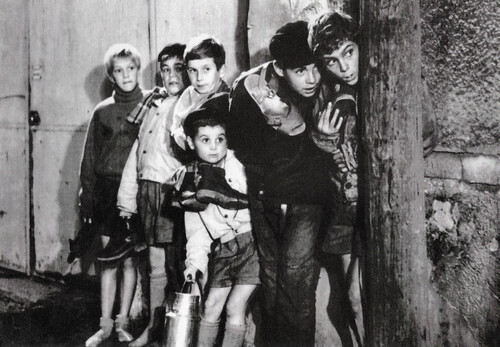
French photo. Publicity still for La guerre des boutons/The War of the Buttons (Yves Robert, 1962).
Sources: DB DuMonteil (IMDb), Wikipedia (French, German, Dutch and English) and IMDb.

French postcard by Editions La Malibran, Paris, in the Collection Cinéma, no. CF 70. Photo: Martin Lartigue as Petit Gibus in La guerre des boutons/The War of the Buttons (Yves Robert, 1962).

Big French postcard by Les Cinemas Independants Parisiennes, Paris. Photo: publicity still for La guerre des boutons/The War of the Buttons (Yves Robert, 1962).
This calls for revenge
La guerre des boutons/The War of the Buttons (Yves Robert, 1962) is based on 'La Guerre des boutons', a novel by Louis Pergaud (1882–1915), who was killed in action in World War I. His works portray a fervent anti-militarism.
At the beginning of a new school year, it is customary for the children of the village of Longeverne and the children of the neighbouring village of Velrans to clash. The children then fight a real war. The boys from Longeverne are angry with the boys from the neighbouring village of Velrans because they have snatched away all their customers by selling tuberculosis stamps.
This calls for revenge, so the boys from Longeverne, led by their leader Lebrac, go to war against the boys from Velrans. When the boys from Longeverne take a prisoner during the battle, Lebrac comes up to dishonour the prisoner. He cuts all the buttons off his clothes so that he has to walk home with his clothes in tatters.
During the boys' next battle, Lebrac is captured again and stripped of his buttons. When he returns home with his clothes torn, his brutal father beats him up for it. But Lebrac is used to being beaten by his father and does not let this stop him from playing war games.
His new plan is to go into battle naked to avoid dishonour during a battle. And so the boys from Longeverne fight naked against the boys from Velrans. Although they win the battle, they can't celebrate their victory because it gives them colds. So Lebrac comes up with a new ruse.

French postcard by Carterie artistique et cinématographique, Pont du Casse in the Encyclopédie du Cinéma / A.D.A.G.P, Paris, no. EDC 1859. Poster illustration: Raymond Savignac. Poster for La guerre des boutons/The War of the Buttons (Yves Robert, 1962).

French postcard by Carterie artistique et cinématographique, Pont du Casse in the Encyclopédie du Cinéma / A.D.A.G.P, Paris, no. EDC 3177. Poster illustration: Raymond Savignac. Poster for La guerre des boutons/The War of the Buttons (Yves Robert, 1962).
Anyone who watches the movie will love him
Yves Robert had previously worked mainly as an actor and gained recognition as a director with this film. He remained largely faithful to Louis Pergaud's children's book but moved the plot - set at the beginning of the 20th century - to the present day.
La guerre des boutons/The War of the Buttons (Yves Robert, 1962) stars young and largely untrained actors including André Treton as Lebrac, Michel Isella as l'Aztec and Martin Lartigue as Petit Gibus. Petit Gibus's line of dialogue - uttered in frustration - 'Si j'aurais su, j'aurais pas v'nu' ("If I woulda known, I wouldn'ta come), with its incorrect grammar (the correct form should be: "Si j'avais su, je ne serais pas venu") has become a familiar tagline in France (the line was not in the original novel).
DB DuMonteil at IMDb : "Yves Robert transposed the action to the rural sixties. He gathered lots and lots of children whom he directed masterfully. "Magna cum laude", first class honours, for young Petit Gibus! Anyone who watches the movie will love him: he's so funny when he gets drunk! Shot in black and white, the film will remind you of your schooldays."
La guerre des boutons/The War of the Buttons (1962) won France's Prix Jean Vigo. There have been several film adaptations. The first, directed by Jacques Daroy, was released in 1936. The film was remade in Ireland in 1994 as War of the Buttons, in an Irish setting. In 2011, two different film adaptations were released in French cinemas at the same time to mark the upcoming 100th anniversary of the novel.
In 2018, a board game of the same name was released using the book and film as a basis. Andreas Steding created the game with a graphic design by Harald Lieske. German publisher ADC Blackfire Entertainment GmbH published the game.

French photo. Publicity still for La guerre des boutons/The War of the Buttons (Yves Robert, 1962).
Sources: DB DuMonteil (IMDb), Wikipedia (French, German, Dutch and English) and IMDb.
Published on April 24, 2024 22:00
April 23, 2024
Claire Lotto
Claire Lotto (1893-1952) was a German dancer and silent film actress. Between 1916 and 1933, she appeared in 41 films. Lotto married German film actor Carl de Vogt, with whom she had a son, Karl Franz de Vogt.
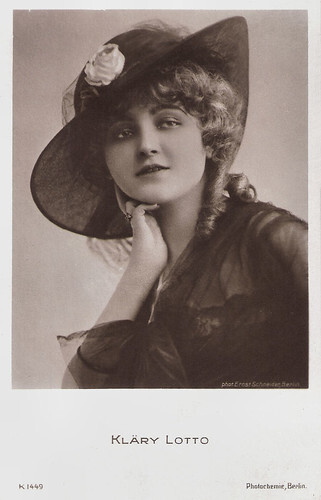
German postcard by Photochemie, no. K. 1449. Photo: Ernst Schneider, Berlin.
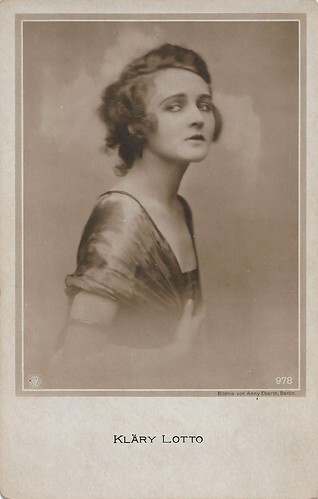
German postcard by NPG, no. 978. Photo: Anny Eberth, Berlin.
Hungarian films with Béla Lugosi
Claire Lotto was born Klara Elsbeth Alma Harnisch in 1893 in Kasekow, Pomerania, Germany (now Casekow, Brandenburg, Germany). She was also known as Cläre Lotto and Kläry Lotto.
As a dancer at the Hofburg in Vienna, she performed also in Budapest, Moscow and Berlin. In the 1910s, she made her film debut in Hungary.
She appeared in several film dramas directed by the young Michael Curtiz , including Az utolsó hajna/The Last Dawn (Mihaly Kertesz, 1917), Lulu (Mihaly Kertesz, 1917) opposite Béla Lugosi and 99-es számú bérkocsi/Rental Car Number 99 (Mihaly Kertesz, 1918) with Victor Varconi.
From 1920, she acted in German silent cinema. She often co-starred with Carl de Vogt , whom she married in 1922. Together they played in Karl May adaptations like Die Todeskarawane/Caravan of Death (Josef Stein, 1920) and Auf den Trümmern des Paradieses/On the Brink of Paradise (Josef Stein, 1920), starring De Vogt as Kara Ben Nemsi.
These films were followed by many dramas, adventure films and comedies till 1925.
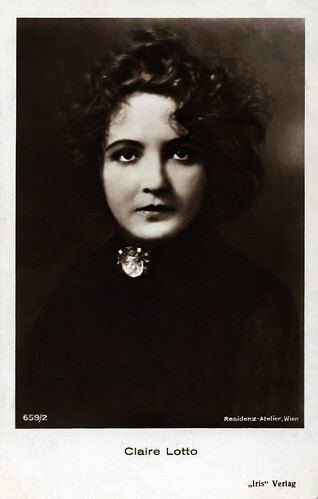
Austrian postcard by Iris-Verlag, no. 659/2. Photo: Residenz-Atelier, Wien (Vienna).
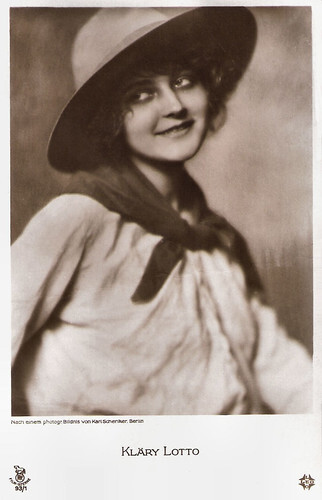
German postcard by Rotophot in the Film Sterne series, no. 93/1. Photo: Karl Schenker, Berlin / Leo.
The Sister of Henny Porten
Claire Lotto played the sister of Henny Porten in In Prater (Peter Paul Felner, 1924). While Porten marries a count, Claire marries a train driver. Yet, both women are pursued by a lustful immoral baron ( Angelo Ferrari ), which creates tensions between the sisters and between husbands and wives. Things become worse when the baron is found dead...
In 1925 Lotto had female leads in e.g. the military farce Zapfenstreich/Taps (Conrad Wiene, 1925) and Am besten gefällt mir die Lore/I like Lore best (Josef Stein, 1925).
By the late 1920s, Lotto's parts became smaller, though she still had the lead in a minor production, Gestrandete Menschen/Stranded People (Kurt Nehrke, 1927), with Erich Kaiser-Titz .
After two German early sound films, Claire Lotto quit the film sets for good.
She died in Berlin, Germany in 1952, aged 58, from undisclosed causes. With Carl de Vogt, she had a son, Karl Franz de Vogt (1917).
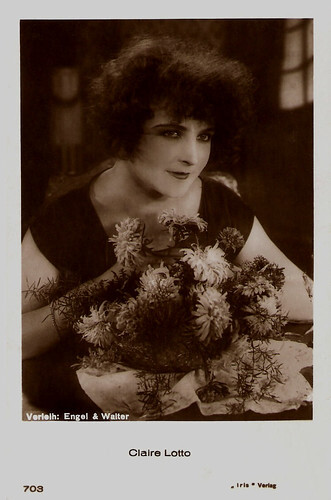
Austrian postcard by Iris-Verlag, no. 703. Photo: Engel & Walter.
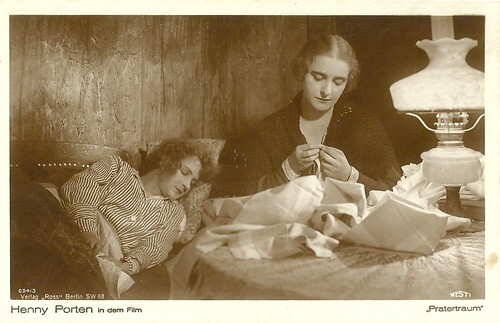
German postcard by Ross Verlag, no. 694/3. Photo: Atlantic Film / Westi Film. Henny Porten and Claire Lotto in Pratertraum/Prater. Die Erlebnisse zweier Nähmädchen (Peter Paul Felner, 1924).
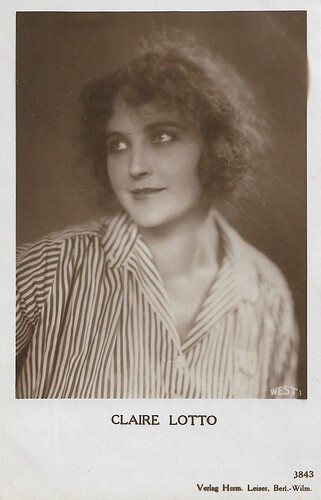
German postcard by Verlag Hermann Leiser, no. 3843. Photo: Westi.
Sources: Wikipedia (German and English) and .

German postcard by Photochemie, no. K. 1449. Photo: Ernst Schneider, Berlin.

German postcard by NPG, no. 978. Photo: Anny Eberth, Berlin.
Hungarian films with Béla Lugosi
Claire Lotto was born Klara Elsbeth Alma Harnisch in 1893 in Kasekow, Pomerania, Germany (now Casekow, Brandenburg, Germany). She was also known as Cläre Lotto and Kläry Lotto.
As a dancer at the Hofburg in Vienna, she performed also in Budapest, Moscow and Berlin. In the 1910s, she made her film debut in Hungary.
She appeared in several film dramas directed by the young Michael Curtiz , including Az utolsó hajna/The Last Dawn (Mihaly Kertesz, 1917), Lulu (Mihaly Kertesz, 1917) opposite Béla Lugosi and 99-es számú bérkocsi/Rental Car Number 99 (Mihaly Kertesz, 1918) with Victor Varconi.
From 1920, she acted in German silent cinema. She often co-starred with Carl de Vogt , whom she married in 1922. Together they played in Karl May adaptations like Die Todeskarawane/Caravan of Death (Josef Stein, 1920) and Auf den Trümmern des Paradieses/On the Brink of Paradise (Josef Stein, 1920), starring De Vogt as Kara Ben Nemsi.
These films were followed by many dramas, adventure films and comedies till 1925.

Austrian postcard by Iris-Verlag, no. 659/2. Photo: Residenz-Atelier, Wien (Vienna).

German postcard by Rotophot in the Film Sterne series, no. 93/1. Photo: Karl Schenker, Berlin / Leo.
The Sister of Henny Porten
Claire Lotto played the sister of Henny Porten in In Prater (Peter Paul Felner, 1924). While Porten marries a count, Claire marries a train driver. Yet, both women are pursued by a lustful immoral baron ( Angelo Ferrari ), which creates tensions between the sisters and between husbands and wives. Things become worse when the baron is found dead...
In 1925 Lotto had female leads in e.g. the military farce Zapfenstreich/Taps (Conrad Wiene, 1925) and Am besten gefällt mir die Lore/I like Lore best (Josef Stein, 1925).
By the late 1920s, Lotto's parts became smaller, though she still had the lead in a minor production, Gestrandete Menschen/Stranded People (Kurt Nehrke, 1927), with Erich Kaiser-Titz .
After two German early sound films, Claire Lotto quit the film sets for good.
She died in Berlin, Germany in 1952, aged 58, from undisclosed causes. With Carl de Vogt, she had a son, Karl Franz de Vogt (1917).

Austrian postcard by Iris-Verlag, no. 703. Photo: Engel & Walter.

German postcard by Ross Verlag, no. 694/3. Photo: Atlantic Film / Westi Film. Henny Porten and Claire Lotto in Pratertraum/Prater. Die Erlebnisse zweier Nähmädchen (Peter Paul Felner, 1924).

German postcard by Verlag Hermann Leiser, no. 3843. Photo: Westi.
Sources: Wikipedia (German and English) and .
Published on April 23, 2024 22:00
April 22, 2024
Karen Morley
Karen Morley (1909-2003) was an American film actress who appeared in such MGM films as Scarface (1932) and Dinner at Eight (1932). Her career was broken in 1947 by the House Committee on Un-American Activities.
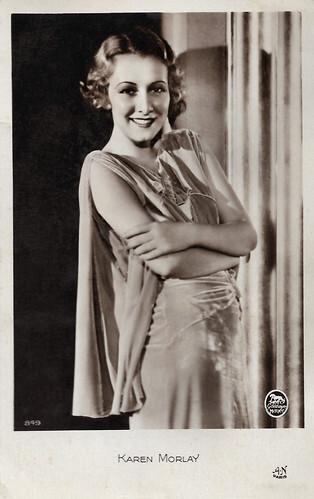
French postcard by A.N., Paris, no. 849. Photo: Metro-Goldwyn-Mayer.
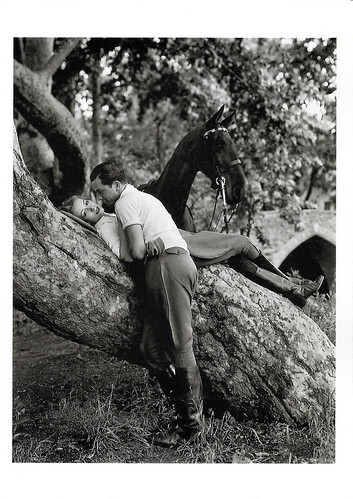
British postcard by Foto-Roff in the Black & Whites Gallery, London, no. 1198. Photo: Kobal Collection. Karen Morley and boyfriend Robert Young , 1932.
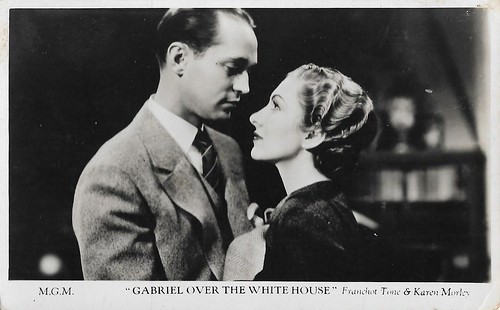
British postcard by Film Weekly. Photo: M.G.M. Franchot Tone and Karen Morley in Gabriel over the White House (Gregory La Cava, 1933).
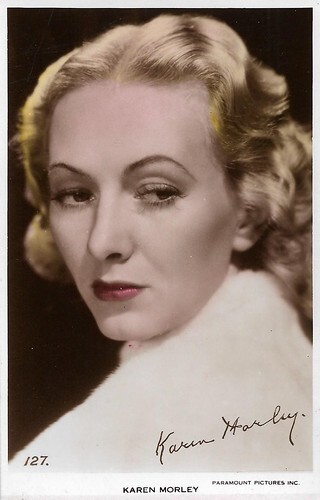
British Art Photo postcard, no. 127. Photo: Paramount Pictures.
Rehearsal replacements for Greta Garbo
Karen Morley was born Mildred Linton in Ottumwa, Iowa in 1909. As a child, she was adopted by a well-to-do family who moved to California during the 1920s. She attended Hollywood High School and studied for a career in medicine at UCLA, but a class in theatre changed her career ambitions. Karen dropped out of college to join the Los Angeles Civic Repertory Theatre and the Pasadena Playhouse.
At the Pasadena Playhouse, she was discovered by director Clarence Brown when he was looking for rehearsal replacements for Greta Garbo . He cast her alongside Garbo and Robert Montgomery in the drama Inspiration (Clarence Brown, 1931).
Howard Hughes chose her for the role of blond moll Poppy in Scarface (Howard Hawks, Richard Rosson, 1932) starring Paul Muni . She received a contract with Metro-Goldwyn-Mayer and was selected as one of the WAMPAS Baby Stars in 1931. That year, she married director Charles Vidor and had a son with him, Michael Karoly.
Her other films included The Mask of Fu Manchu (Charles Brabin, 1932) with Boris Karloff , the mystery Arsene Lupin (Jack Conway, 1933) starring John Barrymore , the political fantasy Gabriel Over the White House (Gregory La Cava, 1933), and the all-star comedy drama Dinner at Eight (George Cukor, 1933).
In 1934, Morley left MGM after arguments about her roles and private life, including her intention to start a family. King Vidor entrusted her with the leading role in his New Deal propaganda film Our Daily Bread (1934). She continued to work as a freelance performer and appeared in Michael Curtiz 's Black Fury (1935) with Paul Muni and The Littlest Rebel (David Butler, 1935) with Shirley Temple . She only appeared in a few films from this time onwards, as it was difficult to make a film career at that time without the backing of a major film studio.
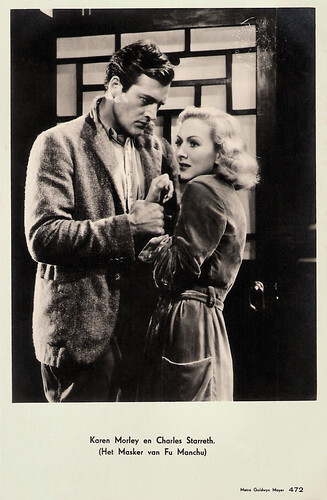
Dutch postcard, no. 472. Photo: Metro-Goldwyn-Mayer. Karen Morley and Charles Starrett in The Mask of Fu Manchu (Charles Brabin, 1932).
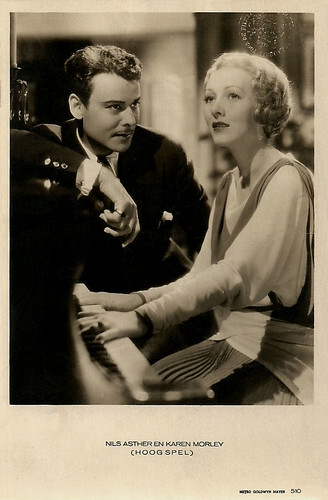
Dutch postcard, no. 510. Photo: Metro Goldwyn Mayer. Nils Asther and Karen Morley in Washington Masquerade (Charles Brabin, 1932). The card holds the stamp of the Dutch National Board of Censors. The Dutch title of the film was Hoog Spel (High Stakes).
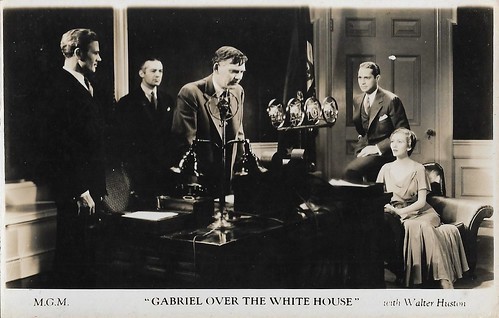
British postcard by Film Weekly. Photo: M.G.M. Walter Huston, Karen Morley and Franchot Tone in Gabriel over the White House (Gregory La Cava, 1933).
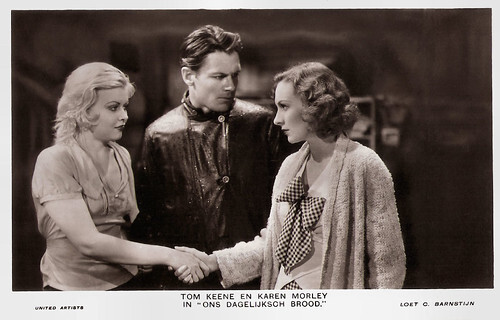
Dutch postcard by Loet C. Barnstijn. Photo: United Artists. Barbara Pepper, Tom Keene and Karen Morley in Our Daily Bread (King Vidor, 1934).
Blacklisted by Hollywood
Karen Morley played Charlotte Lucas, Mr. Collins' wife, in Pride and Prejudice (Robert Z. Leonard, 1940). The film was critically well-received, but it did not advance her career. Morley turned her attention to the stage and acted in three plays on Broadway in 1941 and 1942. In 1943, she divorced Charles Vidor to marry actor Lloyd Gough. The couple remained married to him until he died in 1984.
In 1947, she was called to the HUAC (House Committee on Un-American Activities) because she was suspected to be a member of the Communist Party of the United States. She refused to answer questions and, as a result, ended up blacklisted by Hollywood. Her final films were the Film Noir M (1951) directed by Joseph Losey, who was also blacklisted, and the Western Born to the Saddle (William Beaudine, 1953).
Later, she made brief appearances in the TV series Kung Fu (1973), Kojak (1973) and Police Woman (1975). Morley did not manage to get any more film roles, but she remained active in politics. In 1954, she ran for lieutenant governor of New York for the American Labor Party but was unsuccessful.
In 1993, she appeared in The Great Depression, a documentary TV series. In the series, she talked about how helpless she felt as a privileged Hollywood actress in the face of all the poverty and suffering that surrounded her. She also spoke of her experience making Our Daily Bread and working for King Vidor, whom she described as a conservative who thought that people should willingly help each other without government interference.
In December 1999, at the age of 90, she appeared in Vanity Fair in an article about blacklist survivors, and she was honoured at the San Francisco Film Festival. In 2003, Morley seemed to make a comeback when she was offered a role in the black comedy Duplex (Danny DeVito, 2003) starring Drew Barrymore . However, Karen Morley died of pneumonia at the Motion Picture Country House in Woodland Hills, Los Angeles, at 93.
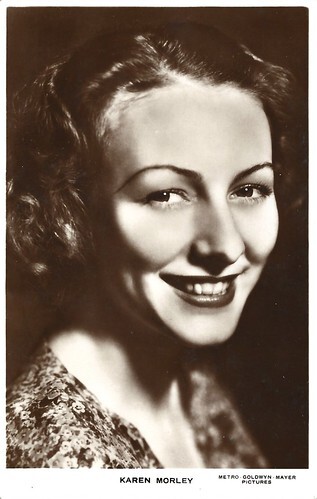
British postcard. Photo: Metro-Goldwyn-Mayer Pictures.
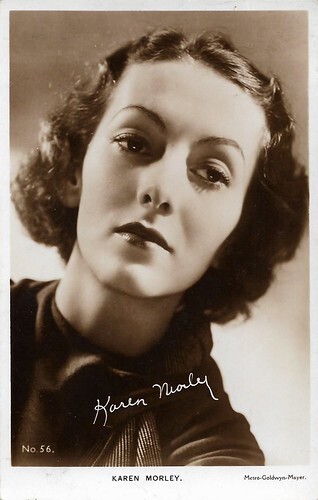
British postcard in the Film-Kurier Series, London, no. 10, Photo: Metro-Goldwyn-Mayer, no. 56.
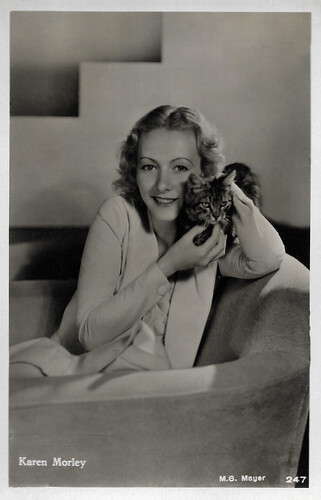
Dutch postcard, no. 247. Photo: Metro-Goldwyn-Mayer.
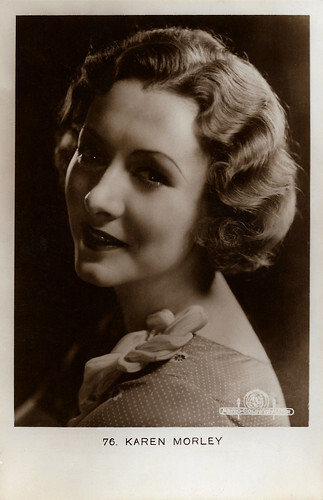
Belgian postcard by P.I.A. Belga Phot., Bruxelles, no. 76. Photo: Metro-Goldwyn-Mayer.
Sources: Wikipedia (Dutch, German, French and English) and .

French postcard by A.N., Paris, no. 849. Photo: Metro-Goldwyn-Mayer.

British postcard by Foto-Roff in the Black & Whites Gallery, London, no. 1198. Photo: Kobal Collection. Karen Morley and boyfriend Robert Young , 1932.

British postcard by Film Weekly. Photo: M.G.M. Franchot Tone and Karen Morley in Gabriel over the White House (Gregory La Cava, 1933).

British Art Photo postcard, no. 127. Photo: Paramount Pictures.
Rehearsal replacements for Greta Garbo
Karen Morley was born Mildred Linton in Ottumwa, Iowa in 1909. As a child, she was adopted by a well-to-do family who moved to California during the 1920s. She attended Hollywood High School and studied for a career in medicine at UCLA, but a class in theatre changed her career ambitions. Karen dropped out of college to join the Los Angeles Civic Repertory Theatre and the Pasadena Playhouse.
At the Pasadena Playhouse, she was discovered by director Clarence Brown when he was looking for rehearsal replacements for Greta Garbo . He cast her alongside Garbo and Robert Montgomery in the drama Inspiration (Clarence Brown, 1931).
Howard Hughes chose her for the role of blond moll Poppy in Scarface (Howard Hawks, Richard Rosson, 1932) starring Paul Muni . She received a contract with Metro-Goldwyn-Mayer and was selected as one of the WAMPAS Baby Stars in 1931. That year, she married director Charles Vidor and had a son with him, Michael Karoly.
Her other films included The Mask of Fu Manchu (Charles Brabin, 1932) with Boris Karloff , the mystery Arsene Lupin (Jack Conway, 1933) starring John Barrymore , the political fantasy Gabriel Over the White House (Gregory La Cava, 1933), and the all-star comedy drama Dinner at Eight (George Cukor, 1933).
In 1934, Morley left MGM after arguments about her roles and private life, including her intention to start a family. King Vidor entrusted her with the leading role in his New Deal propaganda film Our Daily Bread (1934). She continued to work as a freelance performer and appeared in Michael Curtiz 's Black Fury (1935) with Paul Muni and The Littlest Rebel (David Butler, 1935) with Shirley Temple . She only appeared in a few films from this time onwards, as it was difficult to make a film career at that time without the backing of a major film studio.

Dutch postcard, no. 472. Photo: Metro-Goldwyn-Mayer. Karen Morley and Charles Starrett in The Mask of Fu Manchu (Charles Brabin, 1932).

Dutch postcard, no. 510. Photo: Metro Goldwyn Mayer. Nils Asther and Karen Morley in Washington Masquerade (Charles Brabin, 1932). The card holds the stamp of the Dutch National Board of Censors. The Dutch title of the film was Hoog Spel (High Stakes).

British postcard by Film Weekly. Photo: M.G.M. Walter Huston, Karen Morley and Franchot Tone in Gabriel over the White House (Gregory La Cava, 1933).

Dutch postcard by Loet C. Barnstijn. Photo: United Artists. Barbara Pepper, Tom Keene and Karen Morley in Our Daily Bread (King Vidor, 1934).
Blacklisted by Hollywood
Karen Morley played Charlotte Lucas, Mr. Collins' wife, in Pride and Prejudice (Robert Z. Leonard, 1940). The film was critically well-received, but it did not advance her career. Morley turned her attention to the stage and acted in three plays on Broadway in 1941 and 1942. In 1943, she divorced Charles Vidor to marry actor Lloyd Gough. The couple remained married to him until he died in 1984.
In 1947, she was called to the HUAC (House Committee on Un-American Activities) because she was suspected to be a member of the Communist Party of the United States. She refused to answer questions and, as a result, ended up blacklisted by Hollywood. Her final films were the Film Noir M (1951) directed by Joseph Losey, who was also blacklisted, and the Western Born to the Saddle (William Beaudine, 1953).
Later, she made brief appearances in the TV series Kung Fu (1973), Kojak (1973) and Police Woman (1975). Morley did not manage to get any more film roles, but she remained active in politics. In 1954, she ran for lieutenant governor of New York for the American Labor Party but was unsuccessful.
In 1993, she appeared in The Great Depression, a documentary TV series. In the series, she talked about how helpless she felt as a privileged Hollywood actress in the face of all the poverty and suffering that surrounded her. She also spoke of her experience making Our Daily Bread and working for King Vidor, whom she described as a conservative who thought that people should willingly help each other without government interference.
In December 1999, at the age of 90, she appeared in Vanity Fair in an article about blacklist survivors, and she was honoured at the San Francisco Film Festival. In 2003, Morley seemed to make a comeback when she was offered a role in the black comedy Duplex (Danny DeVito, 2003) starring Drew Barrymore . However, Karen Morley died of pneumonia at the Motion Picture Country House in Woodland Hills, Los Angeles, at 93.

British postcard. Photo: Metro-Goldwyn-Mayer Pictures.

British postcard in the Film-Kurier Series, London, no. 10, Photo: Metro-Goldwyn-Mayer, no. 56.

Dutch postcard, no. 247. Photo: Metro-Goldwyn-Mayer.

Belgian postcard by P.I.A. Belga Phot., Bruxelles, no. 76. Photo: Metro-Goldwyn-Mayer.
Sources: Wikipedia (Dutch, German, French and English) and .
Published on April 22, 2024 22:00
April 21, 2024
Photo by Freiherr Wolff von Gudenberg
Freiherr (Baron) Wolff von Gudenberg (1890-1961 or 1964) was a photographer who was noted and fashionable in the 1920s and 1930s in Berlin. Wolff von Gudenberg is the name of an old Hessian noble family that was raised to the rank of baron in 1873. He photographed actors like Marlene Dietrich and Fritzi Massary, dancers like Marianne Winkelstern and La Jana, and international celebrities such as Josephine Baker and Anna May Wong. His photos appeared in magazines such as Die Dame, newspapers like Berliner Illustrirte Zeitung (BIZ), and on countless postcards by Ross Verlag and other publishers. To commemorate this forgotten photographer, we selected 20 postcards with his portraits. Marlene Pilaete added three special cigarette cards of Marlene Dietrich to the post.
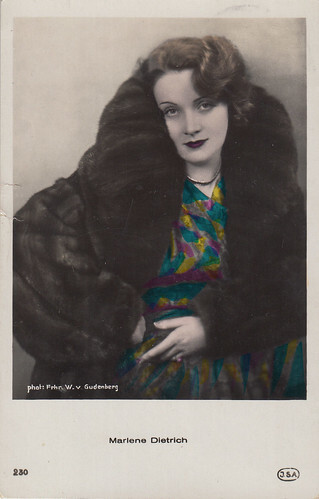
Dutch postcard by JSA, no. 230. Photo: Frhr. W. von Gudenberg. Collection: Marlene Pilaete.
Marlene Dietrich (1901-1992) was the first German actress who succeeded in Hollywood. Throughout her long career, she constantly reinvented herself. In 1920s Berlin, she started as a cabaret singer, chorus girl, and film actress. In the 1930s, she became a Hollywood star, then a World War II frontline entertainer, and finally, she was an international stage show performer from the 1950s till the 1970s. Now we remember her as one of the icons of the 20th century.
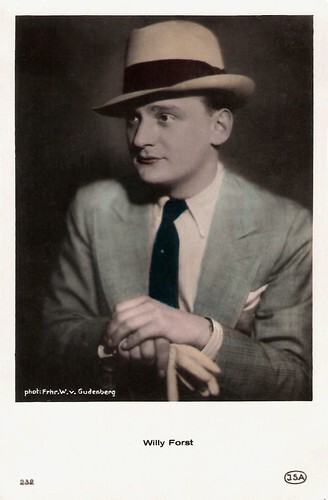
Dutch postcard by JSA, no. 232. Photo: Freiherr Wolff von Gudenberg.
The Austrian actor Willi Forst (1903-1980) was a darling of the German-speaking public. He was also one of the most significant directors, producers, writers and stars of the Wiener Filme, the light Viennese musical comedies of the 1930s.
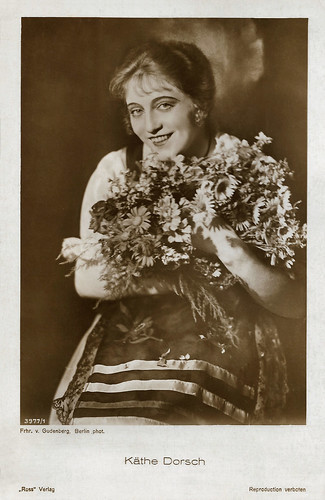
German postcard by Ross Verlag, no. 3977/1, 1928-1929. Photo: Frhr. v. Gudenberg, Berlin.
German actress Käthe Dorsch (1890-1957) was a famous stage actress in Vienna and Berlin. She also made several silent and sound films.
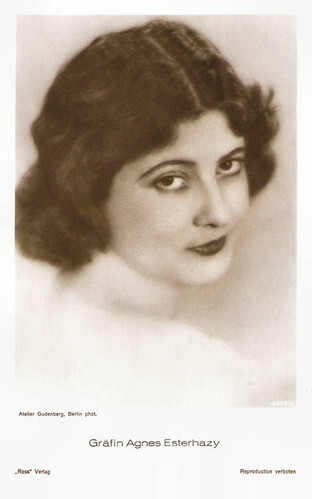
German postcard by Ross Verlag, no. 4869/2, 1929-1930. Photo: Atelier Gudenberg, Berlin.
Hungarian film actress (Gräfin) Agnes Esterhazy (1891-1956) worked mainly in the silent cinema of Austria and Germany. The countess appeared in more than 30 films between 1920 and 1943.
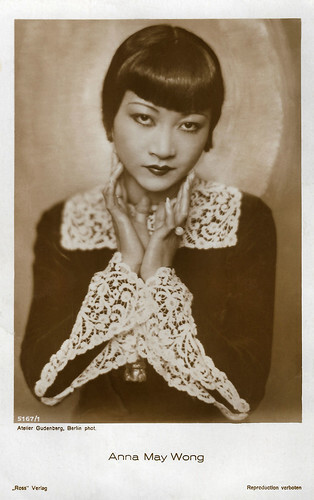
German postcard by Ross Verlag, no. 5167/1, 1930-1931. Photo: Atelier Gudenberg, Berlin.
Anna May Wong (1905-1961) was the first Chinese American movie star and the first Asian American actress to gain international recognition. Frustrated by the stereotypical supporting roles she reluctantly played in Hollywood, Wong left for Europe, where she starred in such classics as Piccadilly (1929).
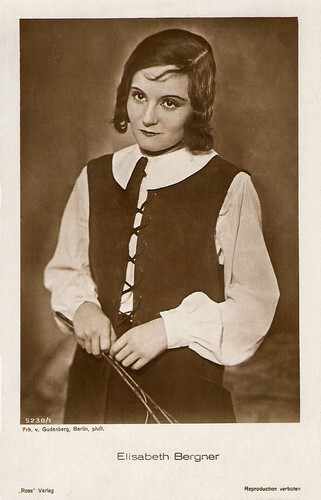
German postcard by Ross Verlag, no. 5230/1, 1930-1931. Photo: Frhr. von Gudenberg, Berlin. Elisabeth Bergner in Der Geiger von Florenz (Paul Czinner, 1926).
The profoundly sensitive acting of Austrian-British actress Elisabeth Bergner (1897-1986) influenced the German cinema of the 1920s and 1930s. She specialised in the bisexual type that she portrayed in Der Geiger von Florenz and other film and stage roles. Nazism forced her to go into exile, but she worked successfully in the West End and on Broadway.
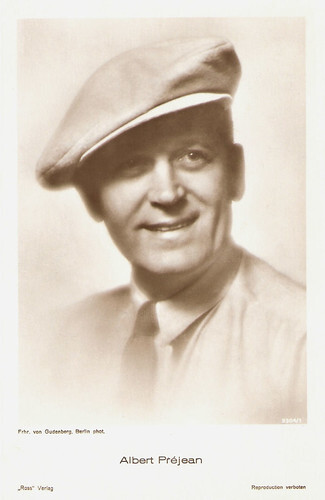
German postcard by Ross Verlag, no. 5304/1, 1930-1931. Photo: Frhr. von Gudenberg, Berlin.
French actor and singer Albert Préjean (1894-1979) was a former WWI flying ace. He is best known for playing heroes in the silent films of René Clair, and for playing George Simenon's detective Maigret.
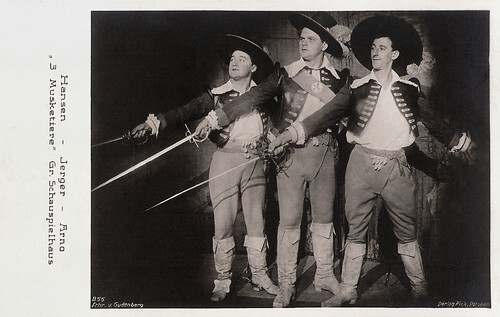
German postcard by Verlag Piek, Postdam, no. 855. Photo: Frhr. von Gudenberg. Max Hansen , Alfred Jerger and Siegfried Arno in the play 'Die drei Musketiere' (The Three Musketeers, 1929) at the Grosse Schauspielhaus.
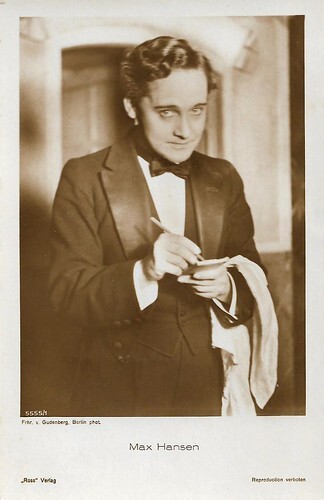
German postcard by Ross Verlag, no. 5555/1, 1930-1931. Photo: Freiherr von Gudenberg, Berlin.
Danish cabaret artist, actor, comedian, and singer Max Hansen (1897-1961) was known as 'The Little Caruso'. During the 1920s, he was one of the most popular stars in Berlin.
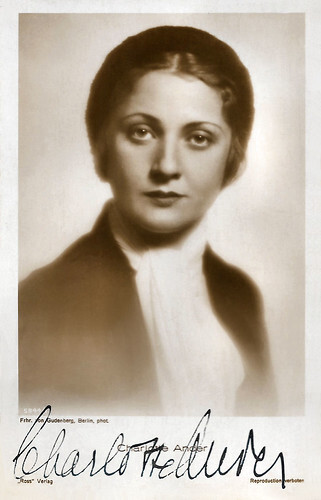
German postcard by Ross Verlag, no. 5844/1, 1930-1931. Photo: Frhr. von Gudenberg, Berlin.
German singer/actress Charlotte Ander (1902-1969) was a star in the silent era before making the transition to sound. The Nazis broke her successful career because she was not of 'pure blood'.
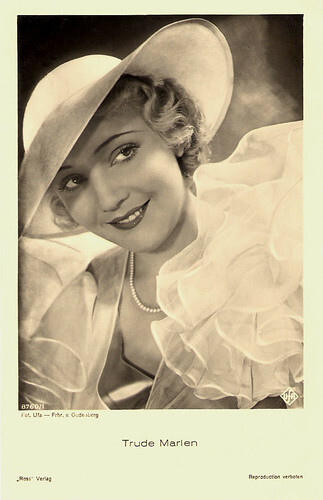
German postcard by Ross Verlag, no. 6760/1, 1931-1932. Photo: Ufa / Frhr. von Gudenberg. Trude Marlen in Spiel mit dem Feuer/Playing with Fire (Ralph Arthur Roberts, 1934).
Trude Marlen (1912-2005), was a curly-locked Austrian leading lady of the 1930s. From 1933 until the 1940s, she made mostly light entertainment films as a Ufa star, in which Willi Forst was often her partner. The Ufa traded her as the German answer to Jean Harlow, but for the most part, she was the Viennese equivalent of the 'girl next door', engaging and uncomplicated.
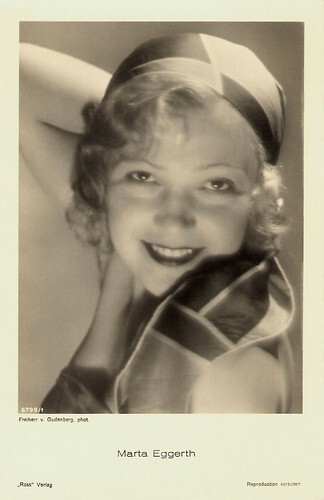
German postcard by Ross Verlag, no. 6799/1, 1931-1932. Photo: Freiherr v. Gudenberg.
Hungarian-born singer and actress Márta Eggerth or Martha Eggerth (1912-2013) maintained a global career for over 70 years. She was the popular and talented star of 30 German and Austrian films of the 1930s.
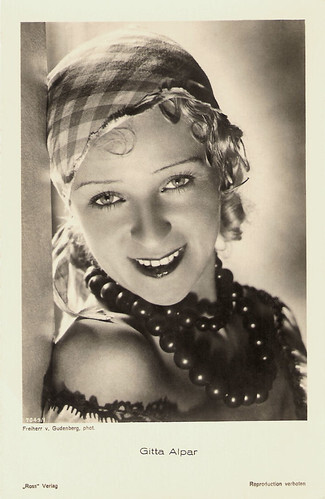
German postcard by Ross Verlag, no. 7049/1, 1932-1933. Photo: Frhr. von Gudenberg Phot.
Hungarian-born Gitta Alpár (1903-1991) was a Jewish actress, opera and operetta singer, and dancer, whose successful career in Germany was broken by the Nazis.
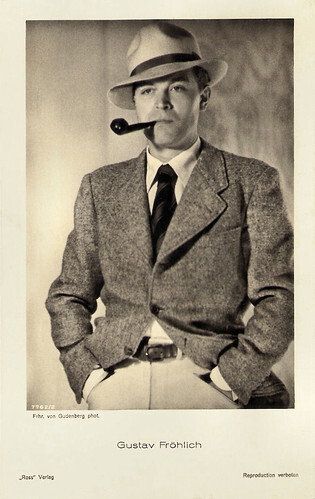
German postcard by Ross Verlag, no. 7762/2, 1932-1933. Photo: Frhr. von Gudenberg.
Smart German actor Gustav Fröhlich (1902-1987) played Freder Fredersen in the classic Metropolis (1927) and became a popular star in light comedies. After the war, he tried to escape from the standard role of a charming gentleman with the part of a doomed painter in Die Sünderin (1951), but the effort went down into a scandal.
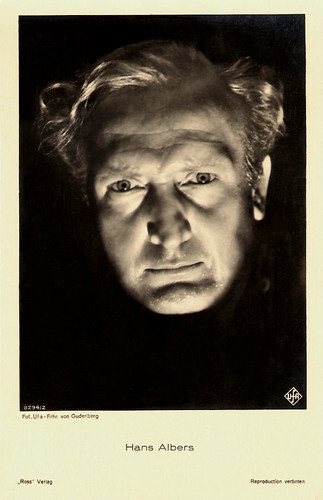
German Postcard by Ross Verlag, no. 8294/12, 1933-1934. Photo: Frhr. von Gudenberg / Ufa.
Jovial, pleasantly plump Hans Albers (1891-1960) was a superstar of German cinema between 1930 and 1945. He was also one of the most popular German singers of the twentieth century. His song Auf der Reeperbahn nachts um halb eins (On the Reeperbahn at half past midnight) is the unofficial anthem of Hamburg’s neighbourhood of St. Pauli, famous for its brothels, music and nightclubs.
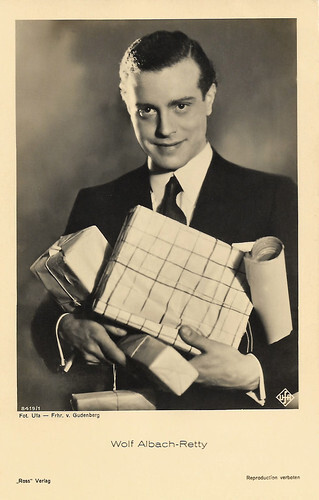
German postcard by Ross Verlag, no. 8419/1, 1933-1934. Photo: Ufa / Frhr. von Gudenberg.
The Austrian-German actor Wolf Albach-Retty (1906-1967) is nowadays best known as the father of Romy Schneider, but during the 1930s he was a popular leading man of German cinema.
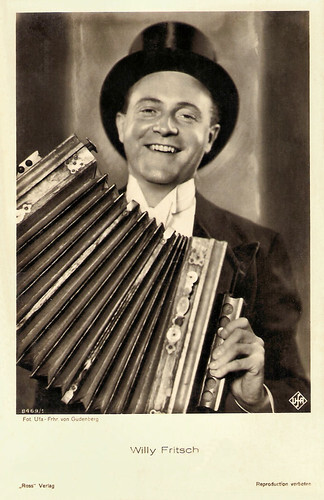
German postcard by Ross Verlag, no. 8469/1, 1933-1934. Photo: Ufa / Frhr. von Gudenberg.
Willy Fritsch (1901-1973) was the immensely popular ‘Sunny Boy’ of the Ufa operettas of the 1930s and 1940s.
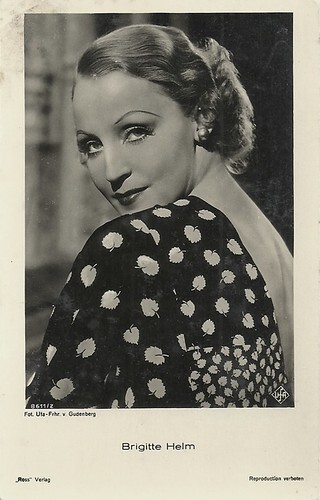
German postcard by Ross Verlag, no. 8611/2, 1933-1934. Photo: Freiherr von Gudenberg / Ufa.
German actress Brigitte Helm (1908-1996) is still famous for her dual role as Maria and her double the evil Maria, the Maschinenmensch, in the silent SF classic Metropolis (Fritz Lang, 1927). After Metropolis she made over 30 films in which she almost always had the starring role. She easily made the transition to sound films, before she abruptly retired in 1935.
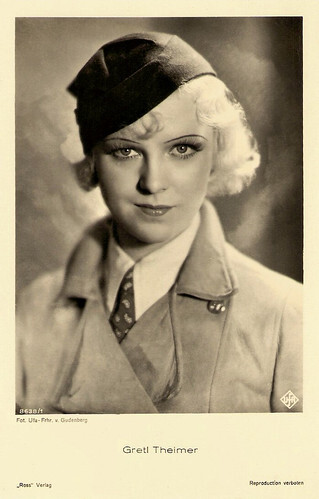
German postcard by Ross Verlag, no. 8638/1, 1933-1934. Photo: Frhr. von Gudenberg / Ufa.
Blonde Austrian actress and singer Gretl Theimer (1911-1972) arrived in the German cinema with the sound film and had an impressive career in the 1930s.
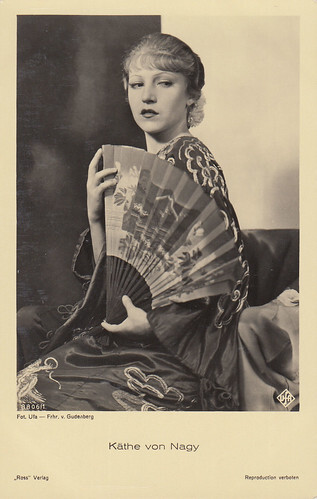
German postcard by Ross Verlag, no. 8806/1, 1933-1934. Photo: Ufa / Frhr. von Gudenberg. Collection: Marlene Pilaete.
Hungarian actress Käthe von Nagy (1904-1973) started as the ‘Backfish’ of German films of the late 1920s. In the early 1930s, she became a fashionable and charming star of German and French cinema.
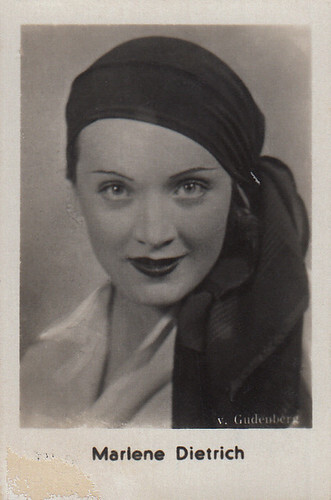
Borg Cigarette card in the Film-u. Bühnen-Lieblinge series, Serie B, Bild 86. Photo: Freiherr Wolff von Gudenberg. Collection: Marlene Pilaete.
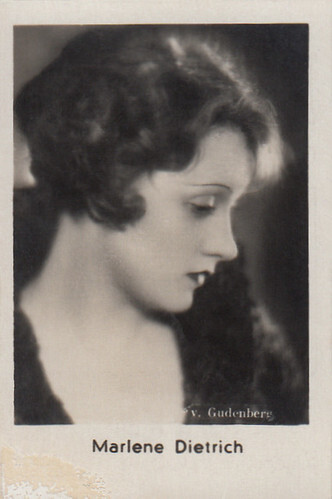
Borg Cigarette card in the Film-u. Bühnen-Lieblinge series, Serie B, Bild 112. Photo: Freiherr Wolff von Gudenberg. Collection: Marlene Pilaete.
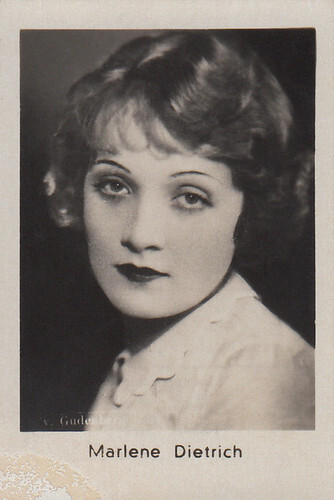
Borg Cigarette card in the Film-u. Bühnen-Lieblinge series, Serie B, Bild 89. Photo: Freiherr Wolff von Gudenberg. Collection: Marlene Pilaete.
Sources: Un regard oblique, ArtNet and RKD (Dutch).

Dutch postcard by JSA, no. 230. Photo: Frhr. W. von Gudenberg. Collection: Marlene Pilaete.
Marlene Dietrich (1901-1992) was the first German actress who succeeded in Hollywood. Throughout her long career, she constantly reinvented herself. In 1920s Berlin, she started as a cabaret singer, chorus girl, and film actress. In the 1930s, she became a Hollywood star, then a World War II frontline entertainer, and finally, she was an international stage show performer from the 1950s till the 1970s. Now we remember her as one of the icons of the 20th century.

Dutch postcard by JSA, no. 232. Photo: Freiherr Wolff von Gudenberg.
The Austrian actor Willi Forst (1903-1980) was a darling of the German-speaking public. He was also one of the most significant directors, producers, writers and stars of the Wiener Filme, the light Viennese musical comedies of the 1930s.

German postcard by Ross Verlag, no. 3977/1, 1928-1929. Photo: Frhr. v. Gudenberg, Berlin.
German actress Käthe Dorsch (1890-1957) was a famous stage actress in Vienna and Berlin. She also made several silent and sound films.

German postcard by Ross Verlag, no. 4869/2, 1929-1930. Photo: Atelier Gudenberg, Berlin.
Hungarian film actress (Gräfin) Agnes Esterhazy (1891-1956) worked mainly in the silent cinema of Austria and Germany. The countess appeared in more than 30 films between 1920 and 1943.

German postcard by Ross Verlag, no. 5167/1, 1930-1931. Photo: Atelier Gudenberg, Berlin.
Anna May Wong (1905-1961) was the first Chinese American movie star and the first Asian American actress to gain international recognition. Frustrated by the stereotypical supporting roles she reluctantly played in Hollywood, Wong left for Europe, where she starred in such classics as Piccadilly (1929).

German postcard by Ross Verlag, no. 5230/1, 1930-1931. Photo: Frhr. von Gudenberg, Berlin. Elisabeth Bergner in Der Geiger von Florenz (Paul Czinner, 1926).
The profoundly sensitive acting of Austrian-British actress Elisabeth Bergner (1897-1986) influenced the German cinema of the 1920s and 1930s. She specialised in the bisexual type that she portrayed in Der Geiger von Florenz and other film and stage roles. Nazism forced her to go into exile, but she worked successfully in the West End and on Broadway.

German postcard by Ross Verlag, no. 5304/1, 1930-1931. Photo: Frhr. von Gudenberg, Berlin.
French actor and singer Albert Préjean (1894-1979) was a former WWI flying ace. He is best known for playing heroes in the silent films of René Clair, and for playing George Simenon's detective Maigret.

German postcard by Verlag Piek, Postdam, no. 855. Photo: Frhr. von Gudenberg. Max Hansen , Alfred Jerger and Siegfried Arno in the play 'Die drei Musketiere' (The Three Musketeers, 1929) at the Grosse Schauspielhaus.

German postcard by Ross Verlag, no. 5555/1, 1930-1931. Photo: Freiherr von Gudenberg, Berlin.
Danish cabaret artist, actor, comedian, and singer Max Hansen (1897-1961) was known as 'The Little Caruso'. During the 1920s, he was one of the most popular stars in Berlin.

German postcard by Ross Verlag, no. 5844/1, 1930-1931. Photo: Frhr. von Gudenberg, Berlin.
German singer/actress Charlotte Ander (1902-1969) was a star in the silent era before making the transition to sound. The Nazis broke her successful career because she was not of 'pure blood'.

German postcard by Ross Verlag, no. 6760/1, 1931-1932. Photo: Ufa / Frhr. von Gudenberg. Trude Marlen in Spiel mit dem Feuer/Playing with Fire (Ralph Arthur Roberts, 1934).
Trude Marlen (1912-2005), was a curly-locked Austrian leading lady of the 1930s. From 1933 until the 1940s, she made mostly light entertainment films as a Ufa star, in which Willi Forst was often her partner. The Ufa traded her as the German answer to Jean Harlow, but for the most part, she was the Viennese equivalent of the 'girl next door', engaging and uncomplicated.

German postcard by Ross Verlag, no. 6799/1, 1931-1932. Photo: Freiherr v. Gudenberg.
Hungarian-born singer and actress Márta Eggerth or Martha Eggerth (1912-2013) maintained a global career for over 70 years. She was the popular and talented star of 30 German and Austrian films of the 1930s.

German postcard by Ross Verlag, no. 7049/1, 1932-1933. Photo: Frhr. von Gudenberg Phot.
Hungarian-born Gitta Alpár (1903-1991) was a Jewish actress, opera and operetta singer, and dancer, whose successful career in Germany was broken by the Nazis.

German postcard by Ross Verlag, no. 7762/2, 1932-1933. Photo: Frhr. von Gudenberg.
Smart German actor Gustav Fröhlich (1902-1987) played Freder Fredersen in the classic Metropolis (1927) and became a popular star in light comedies. After the war, he tried to escape from the standard role of a charming gentleman with the part of a doomed painter in Die Sünderin (1951), but the effort went down into a scandal.

German Postcard by Ross Verlag, no. 8294/12, 1933-1934. Photo: Frhr. von Gudenberg / Ufa.
Jovial, pleasantly plump Hans Albers (1891-1960) was a superstar of German cinema between 1930 and 1945. He was also one of the most popular German singers of the twentieth century. His song Auf der Reeperbahn nachts um halb eins (On the Reeperbahn at half past midnight) is the unofficial anthem of Hamburg’s neighbourhood of St. Pauli, famous for its brothels, music and nightclubs.

German postcard by Ross Verlag, no. 8419/1, 1933-1934. Photo: Ufa / Frhr. von Gudenberg.
The Austrian-German actor Wolf Albach-Retty (1906-1967) is nowadays best known as the father of Romy Schneider, but during the 1930s he was a popular leading man of German cinema.

German postcard by Ross Verlag, no. 8469/1, 1933-1934. Photo: Ufa / Frhr. von Gudenberg.
Willy Fritsch (1901-1973) was the immensely popular ‘Sunny Boy’ of the Ufa operettas of the 1930s and 1940s.

German postcard by Ross Verlag, no. 8611/2, 1933-1934. Photo: Freiherr von Gudenberg / Ufa.
German actress Brigitte Helm (1908-1996) is still famous for her dual role as Maria and her double the evil Maria, the Maschinenmensch, in the silent SF classic Metropolis (Fritz Lang, 1927). After Metropolis she made over 30 films in which she almost always had the starring role. She easily made the transition to sound films, before she abruptly retired in 1935.

German postcard by Ross Verlag, no. 8638/1, 1933-1934. Photo: Frhr. von Gudenberg / Ufa.
Blonde Austrian actress and singer Gretl Theimer (1911-1972) arrived in the German cinema with the sound film and had an impressive career in the 1930s.

German postcard by Ross Verlag, no. 8806/1, 1933-1934. Photo: Ufa / Frhr. von Gudenberg. Collection: Marlene Pilaete.
Hungarian actress Käthe von Nagy (1904-1973) started as the ‘Backfish’ of German films of the late 1920s. In the early 1930s, she became a fashionable and charming star of German and French cinema.

Borg Cigarette card in the Film-u. Bühnen-Lieblinge series, Serie B, Bild 86. Photo: Freiherr Wolff von Gudenberg. Collection: Marlene Pilaete.

Borg Cigarette card in the Film-u. Bühnen-Lieblinge series, Serie B, Bild 112. Photo: Freiherr Wolff von Gudenberg. Collection: Marlene Pilaete.

Borg Cigarette card in the Film-u. Bühnen-Lieblinge series, Serie B, Bild 89. Photo: Freiherr Wolff von Gudenberg. Collection: Marlene Pilaete.
Sources: Un regard oblique, ArtNet and RKD (Dutch).
Published on April 21, 2024 22:00
April 20, 2024
Warner Baxter
Warner Baxter (1889-1951) was an American film actor from the 1910s to the 1940s. Baxter is known for his role as the Cisco Kid in the film In Old Arizona (1928), for which he won the Academy Award for Best Actor at the 2nd Academy Awards. He played the Cisco Kid or a similar character throughout the 1930s. Baxter frequently played womanising, charismatic Latin bandit types in Westerns, but had many other roles throughout his career.
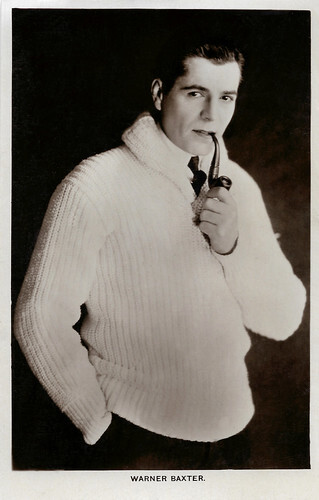
British postcard in the Picturegoer Series, London, no. 165.
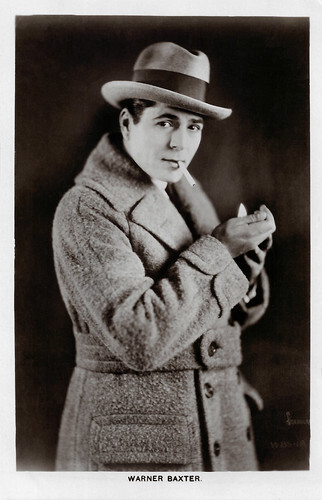
British postcard in the Picturgoer Series, London, no. 165a.
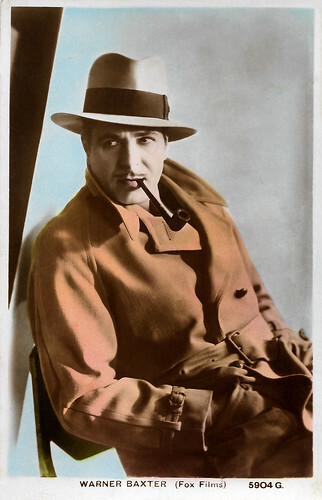
British Valentine's postcard, no. 5904 G. Photo: Fox Films. Caption: Warner Baxter - A Fox Film Star, he received his education in Ohio State University. he made his debut as a screen actor with the Paramount Company in 1921. Talkies gave him the opportunity and he achieved fame with the Fox Films, starring in Daddy Long Legs, and other famous plays. He is 42 years of age and was born at Columbus, Ohio. Married Winifred Bryson.
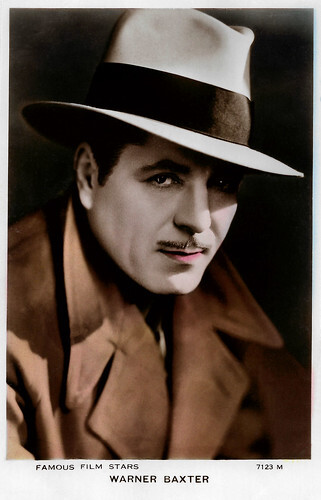
British postcard in the Famous Film Stars series by Valentine's, no. 7123 M. Caption: Warner Baxter - This popular film star began life as a salesman before he found his life-work on the stage and on the films. He has starred in several popular pictures such as 42nd Street and Paddy the Next Best Thing. He was born in Columbus, Ohio on 20th March 1892, and is 5 feet, 11 inches in height.
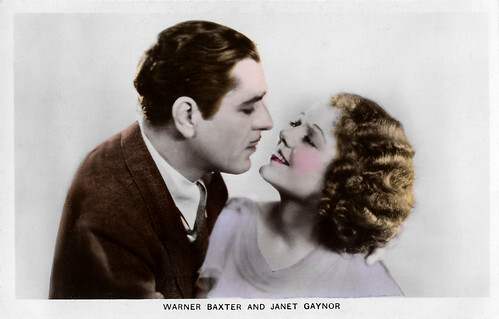
British postcard in the Film Partners Series, London, no. PC3. Photo: Fox. Warner Baxter and Janet Gaynor in One More Spring (Henry King, 1935).
A matinee idol
Warner Leroy Baxter was born in 1889, in Columbus, Ohio. Edwin F. Baxter, a cigar stand operator, and Jennie (Jane) B. Barrett were his parents. His father died before Warner was five, and he and his mother went to live with her brother. Baxter claimed to have an early pre-disposition toward show business: "I discovered a boy a block away who would eat worms and swallow flies for a penny. For one-third of the profits, I exhibited him in a tent."
Mother and son later moved to New York City, where he became active in dramatics, participating in school productions and attending plays. In 1898, the two moved to San Francisco, where he graduated from Polytechnic High School. Both survived the severe earthquake of 1906 but lost all their belongings. They lived in a tent for two weeks "in mortal terror of the fire" and returned to Columbus in 1908.
After selling farm implements for a living, Baxter worked for four months as the partner of Dorothy Shoemaker in an act on the Keith Vaudeville Circuit. In 1910, he joined a theatre group and played vaudeville. This led him to New York City, where he enjoyed his first successes on Broadway. Baxter became a member of The Lambs, a professional theatrical club in NYC, in 1918.
Baxter began his film career as an extra in 1914. His first starring role was in the silent drama Sheltered Daughters (Edward Dillon, 1921) opposite Justine Johnston. In the same year, he acted in First Love (Maurice Campbell, 1921), The Love Charm (Thomas N. Heffron, 1921) with Wanda Hawley, and Cheated Hearts (Hobart Henley, 1921) opposite Herbert Rawlinson .
He soon became a matinee idol. Baxter starred in 48 features during the 1920s. His most notable silent film roles were in the comedy The Awful Truth (Paul Powell, 1925) with Agnes Ayres, and The Great Gatsby (Herbert Brenon, 1926), the first film adaptation of F. Scott Fitzgerald's literary classic. He played the title role of Jay Gatsby opposite Lois Wilson as Daisy. Baxter played an island love interest opposite dancer Gilda Gray in Aloma of the South Seas (Maurice Tourneur, 1926) and an alcoholic doctor in West of Zanzibar (Tod Browning, 1928) with Lon Chaney .
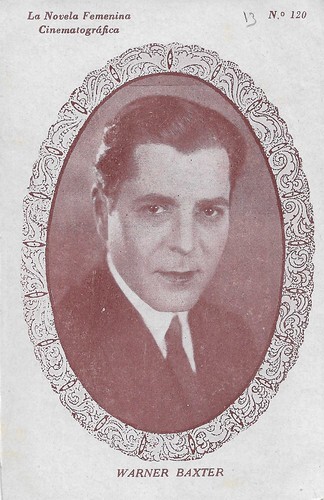
Spanish collectors card by La Novela Femenina Cinematogràfica, no. 120.
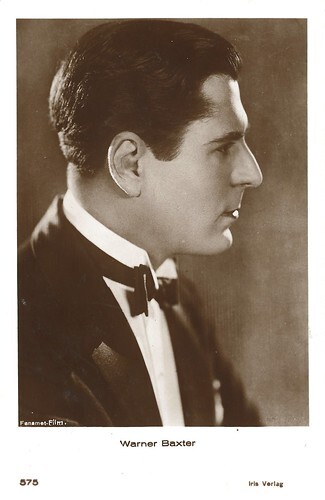
Austrian postcard by Iris Verlag, no. 575. Photo: Fanamet Film.
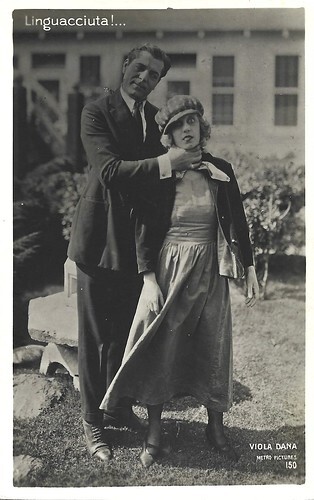
Italian postcard by B & G., B, no. 150. Photo: Metro Pictures. Caption: Linguacciuta!... (Big-mouth/ Sharp tongue). Viola Dana and Warner Baxter in the comedy In Search of a Thrill (Oscar Apfel, 1923). With thanks to Steve Massa for the identification.
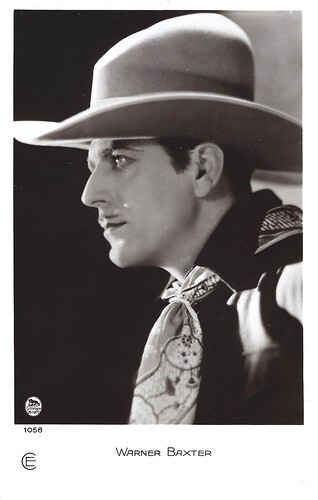
French postcard by Cinémagazine-Edition, no. 1058. Photo: Metro-Goldwyn-Mayer.
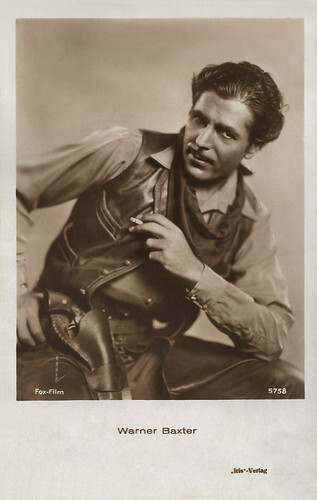
Austrian postcard by Iris Verlag, no. 5758. Photo: Fox-Film.
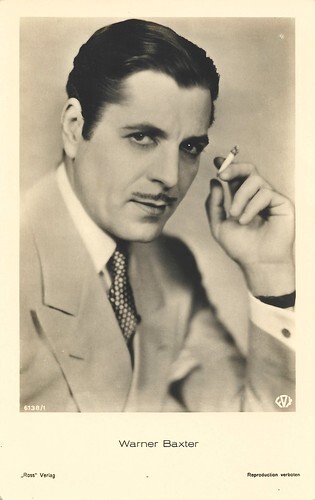
German postcard by Ross Verlag, no. 6138/1, 1931. Photo: Fox. On the back: Dutch-written title: Zijn mooiste weerwraak (His best revenge). It refers to Such men are dangerous (Kenneth Hawks, 1930).
The Cisco Kid
Warner Baxter's most notable starring role was as The Cisco Kid in In Old Arizona (Irving Cummings, 1929), the first all-talking Western. For his role, he won the second Academy Award for Best Actor. He played the Cisco Kid again in the ensemble short film The Stolen Jools (William C. McGann, 1931). Baxter also starred in 42nd Street (Lloyd Bacon, 1933), Grand Canary (Irving Cummings, 1934) and Broadway Bill (Frank Capra, 1934).
Many consider his best role, that of the doctor who treated Abraham Lincoln's assassin, in John Ford's The Prisoner of Shark Island (1936). Other notable sound films were Slave Ship (Tay Garnett, 1937) with Wallace Beery and Kidnapped (Otto Preminger, 1938) with Freddie Bartholomew .
When not acting, Baxter was an inventor who co-created a searchlight for revolvers in 1935. This allowed a shooter to more clearly see a target at night. He also developed a radio device that allowed emergency crews to change traffic signals from two blocks away, providing them a safe passage through intersections.
By 1936, Baxter was the highest-paid actor in Hollywood, but by 1943, he had slipped to B movie roles. He was then known as Dr. Robert Ordway in the Crime Doctor series of 10 films which began with Crime Doctor (Michael Gordon, 1943). However, Baxter was now more comfortable, with his career and life with his wife, actress Winifred Bryson: "It's wonderful. I make two of them (the Crime Doctor films) a year. Columbia has juggled it so I can make two in a row. That takes about eight weeks of my time. The rest of the year I relax. I travel. I enjoy life."
Warner Baxter suffered from arthritis for several years. In 1951, he underwent a lobotomy as a last resort to ease the chronic pain and later that year, he died of pneumonia at age 62. He was interred in Forest Lawn Memorial Park Cemetery in Glendale, California. Baxter has a star on the Hollywood Walk of Fame for his contributions to the motion-picture industry.
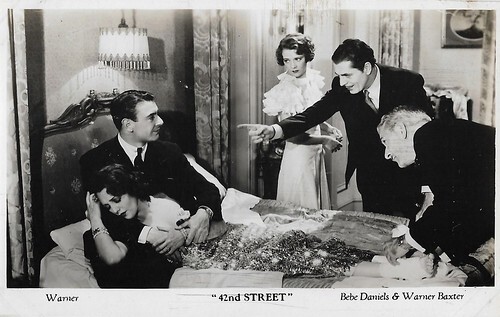
British postcard by Film Weekly. Photo: Warner Bros. Bebe Daniels and Warren Baxter in the musical 42nd Street (Lloyd Bacon, 1933).
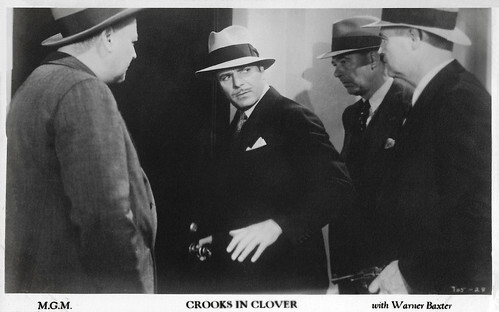
British postcard by Film Weekly. Photo: MGM. Warner Baxter in Penthouse/Crooks in Clover (W.S. Van Dyke, 1933).
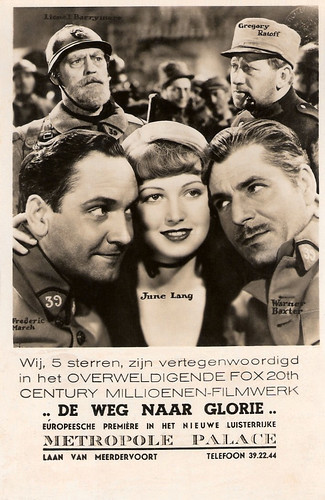
Dutch postcard for Metropole Palace, Den Haag (The Hague). Photos: 20th Century Fox. Fredric March, June Lang, Warner Baxter, Lionel Barrymore, and Gregory Ratoff in The Road to Glory (Howard Hawks, 1936). Caption: We, 5 stars, are represented in the overwhelming Fox 20th Century millions-film work The Way to Glory. European premiere in the new glorious Metropole Palace, Laan van Meerdervoort, telephone 39.22.44.
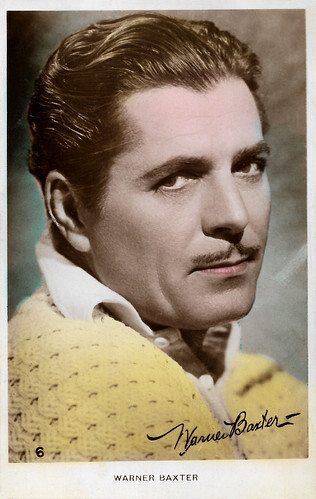
British Art Photo postcard, no. 6.
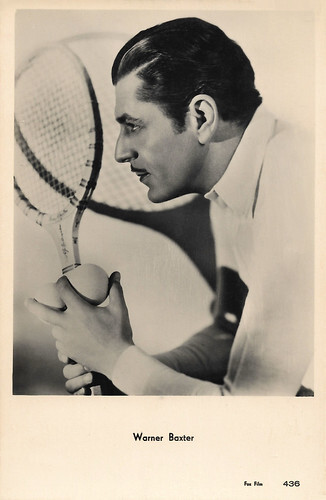
Dutch postcard by JosPe, Arnhem, no. 436. Photo: Fox Film.
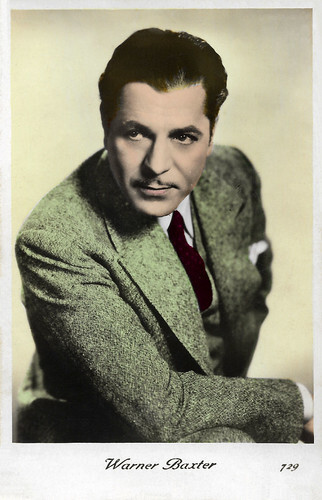
French postcard, no. 729.
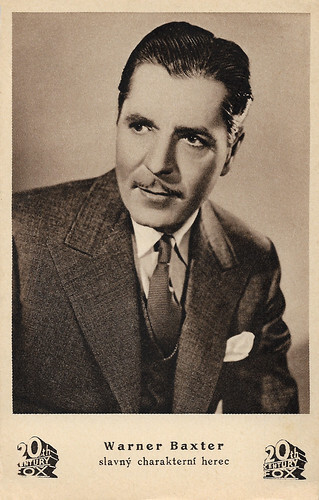
Czechoslovakian postcard by Josef Doležal, Červený Kostelec. Photo: 20th Century Fox. Caption: Warner Baxter, famous character actor.
Sources: (IMDb), Wikipedia (Dutch, German and English) and .

British postcard in the Picturegoer Series, London, no. 165.

British postcard in the Picturgoer Series, London, no. 165a.

British Valentine's postcard, no. 5904 G. Photo: Fox Films. Caption: Warner Baxter - A Fox Film Star, he received his education in Ohio State University. he made his debut as a screen actor with the Paramount Company in 1921. Talkies gave him the opportunity and he achieved fame with the Fox Films, starring in Daddy Long Legs, and other famous plays. He is 42 years of age and was born at Columbus, Ohio. Married Winifred Bryson.

British postcard in the Famous Film Stars series by Valentine's, no. 7123 M. Caption: Warner Baxter - This popular film star began life as a salesman before he found his life-work on the stage and on the films. He has starred in several popular pictures such as 42nd Street and Paddy the Next Best Thing. He was born in Columbus, Ohio on 20th March 1892, and is 5 feet, 11 inches in height.

British postcard in the Film Partners Series, London, no. PC3. Photo: Fox. Warner Baxter and Janet Gaynor in One More Spring (Henry King, 1935).
A matinee idol
Warner Leroy Baxter was born in 1889, in Columbus, Ohio. Edwin F. Baxter, a cigar stand operator, and Jennie (Jane) B. Barrett were his parents. His father died before Warner was five, and he and his mother went to live with her brother. Baxter claimed to have an early pre-disposition toward show business: "I discovered a boy a block away who would eat worms and swallow flies for a penny. For one-third of the profits, I exhibited him in a tent."
Mother and son later moved to New York City, where he became active in dramatics, participating in school productions and attending plays. In 1898, the two moved to San Francisco, where he graduated from Polytechnic High School. Both survived the severe earthquake of 1906 but lost all their belongings. They lived in a tent for two weeks "in mortal terror of the fire" and returned to Columbus in 1908.
After selling farm implements for a living, Baxter worked for four months as the partner of Dorothy Shoemaker in an act on the Keith Vaudeville Circuit. In 1910, he joined a theatre group and played vaudeville. This led him to New York City, where he enjoyed his first successes on Broadway. Baxter became a member of The Lambs, a professional theatrical club in NYC, in 1918.
Baxter began his film career as an extra in 1914. His first starring role was in the silent drama Sheltered Daughters (Edward Dillon, 1921) opposite Justine Johnston. In the same year, he acted in First Love (Maurice Campbell, 1921), The Love Charm (Thomas N. Heffron, 1921) with Wanda Hawley, and Cheated Hearts (Hobart Henley, 1921) opposite Herbert Rawlinson .
He soon became a matinee idol. Baxter starred in 48 features during the 1920s. His most notable silent film roles were in the comedy The Awful Truth (Paul Powell, 1925) with Agnes Ayres, and The Great Gatsby (Herbert Brenon, 1926), the first film adaptation of F. Scott Fitzgerald's literary classic. He played the title role of Jay Gatsby opposite Lois Wilson as Daisy. Baxter played an island love interest opposite dancer Gilda Gray in Aloma of the South Seas (Maurice Tourneur, 1926) and an alcoholic doctor in West of Zanzibar (Tod Browning, 1928) with Lon Chaney .

Spanish collectors card by La Novela Femenina Cinematogràfica, no. 120.

Austrian postcard by Iris Verlag, no. 575. Photo: Fanamet Film.

Italian postcard by B & G., B, no. 150. Photo: Metro Pictures. Caption: Linguacciuta!... (Big-mouth/ Sharp tongue). Viola Dana and Warner Baxter in the comedy In Search of a Thrill (Oscar Apfel, 1923). With thanks to Steve Massa for the identification.

French postcard by Cinémagazine-Edition, no. 1058. Photo: Metro-Goldwyn-Mayer.

Austrian postcard by Iris Verlag, no. 5758. Photo: Fox-Film.

German postcard by Ross Verlag, no. 6138/1, 1931. Photo: Fox. On the back: Dutch-written title: Zijn mooiste weerwraak (His best revenge). It refers to Such men are dangerous (Kenneth Hawks, 1930).
The Cisco Kid
Warner Baxter's most notable starring role was as The Cisco Kid in In Old Arizona (Irving Cummings, 1929), the first all-talking Western. For his role, he won the second Academy Award for Best Actor. He played the Cisco Kid again in the ensemble short film The Stolen Jools (William C. McGann, 1931). Baxter also starred in 42nd Street (Lloyd Bacon, 1933), Grand Canary (Irving Cummings, 1934) and Broadway Bill (Frank Capra, 1934).
Many consider his best role, that of the doctor who treated Abraham Lincoln's assassin, in John Ford's The Prisoner of Shark Island (1936). Other notable sound films were Slave Ship (Tay Garnett, 1937) with Wallace Beery and Kidnapped (Otto Preminger, 1938) with Freddie Bartholomew .
When not acting, Baxter was an inventor who co-created a searchlight for revolvers in 1935. This allowed a shooter to more clearly see a target at night. He also developed a radio device that allowed emergency crews to change traffic signals from two blocks away, providing them a safe passage through intersections.
By 1936, Baxter was the highest-paid actor in Hollywood, but by 1943, he had slipped to B movie roles. He was then known as Dr. Robert Ordway in the Crime Doctor series of 10 films which began with Crime Doctor (Michael Gordon, 1943). However, Baxter was now more comfortable, with his career and life with his wife, actress Winifred Bryson: "It's wonderful. I make two of them (the Crime Doctor films) a year. Columbia has juggled it so I can make two in a row. That takes about eight weeks of my time. The rest of the year I relax. I travel. I enjoy life."
Warner Baxter suffered from arthritis for several years. In 1951, he underwent a lobotomy as a last resort to ease the chronic pain and later that year, he died of pneumonia at age 62. He was interred in Forest Lawn Memorial Park Cemetery in Glendale, California. Baxter has a star on the Hollywood Walk of Fame for his contributions to the motion-picture industry.

British postcard by Film Weekly. Photo: Warner Bros. Bebe Daniels and Warren Baxter in the musical 42nd Street (Lloyd Bacon, 1933).

British postcard by Film Weekly. Photo: MGM. Warner Baxter in Penthouse/Crooks in Clover (W.S. Van Dyke, 1933).

Dutch postcard for Metropole Palace, Den Haag (The Hague). Photos: 20th Century Fox. Fredric March, June Lang, Warner Baxter, Lionel Barrymore, and Gregory Ratoff in The Road to Glory (Howard Hawks, 1936). Caption: We, 5 stars, are represented in the overwhelming Fox 20th Century millions-film work The Way to Glory. European premiere in the new glorious Metropole Palace, Laan van Meerdervoort, telephone 39.22.44.

British Art Photo postcard, no. 6.

Dutch postcard by JosPe, Arnhem, no. 436. Photo: Fox Film.

French postcard, no. 729.

Czechoslovakian postcard by Josef Doležal, Červený Kostelec. Photo: 20th Century Fox. Caption: Warner Baxter, famous character actor.
Sources: (IMDb), Wikipedia (Dutch, German and English) and .
Published on April 20, 2024 22:00
April 19, 2024
Debbie Reynolds
American actress and singer Debbie Reynolds (1932-2016) is best-remembered opposite Gene Kelly in the classic musical Singin' in the Rain (1952). Her career spanned almost 70 years. She starred in more than forty films and was Oscar-nominated for The Unsinkable Molly Brown (1964). Reynolds was also a film historian and a noted collector of film memorabilia, and she was Carrie Fisher's mother.
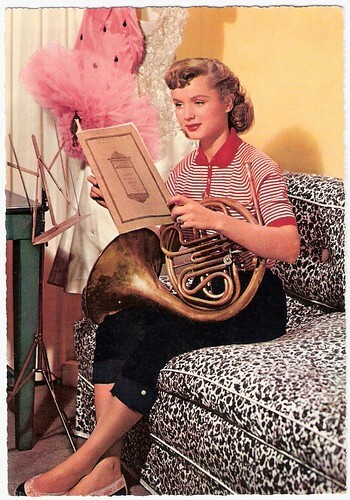
German postcard by Krüger, no. 902/21.
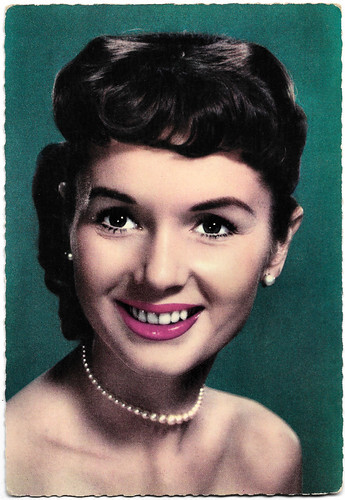
West German postcard by ISV, no. B 27. Publicity still for Bundle of Joy (Norman Taurog, 1956).
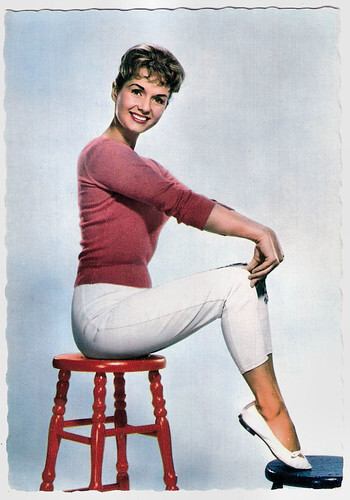
French postcard by M.D., Paris, no. 114.
Most Promising Newcomer
Debbie Reynolds was born Mary Frances Reynolds in El Paso, Texas, in 1932. She was the second child of Maxine N. (Harmon) and Raymond Francis Reynolds, a carpenter who worked for the Southern Pacific Railroad. In 1939, her family moved to Burbank, California. Debbie played the French horn in high school and was a member of the Burbank Youth Symphony.
She planned to go teaching physical education, but the day after she won the 1948 Miss Burbank contest at age 16 impersonating Betty Hutton , Warner Bros. offered her a screen test. Although she wanted to be in show business, the Reynolds family church, the Nazarene, forbade acting. However, Reynolds' father saw her talent and gave his support, seeing it as a means of paying her college costs. In 1950, she graduated from Burbank High School.
Warner Bros gave her a new first name and her first roles in films. When Warner Bros. stopped producing musicals in 1950, she moved to MGM. Her breakout role was Helen Kane in the musical Three Little Words (Richard Thorpe, 1950), about the successful Tin Pan Alley songwriting team of Bert Kalmar ( Fred Astaire ) and Harry Ruby (Red Skelton). Reynolds was nominated for the Golden Globe for Most Promising Newcomer. Her song 'Aba Daba Honeymoon', featured in the film Two Weeks with Love (Roy Rowland, 1950) and sung as a duet with co-star Carleton Carpenter, was the first soundtrack recording to become a top-of-the-chart gold record. It reached number three on the Billboard charts. Her performance in the film greatly impressed the studio, which then gave her a co-starring role in what became her highest-profile film.
At age 19, Debbie Reynolds played her first co-starring role as Kathy Selden in Singin' in the Rain (Stanley Donen, Gene Kelly, 1952). The musical offers a lighthearted depiction of Hollywood in the late 1920s, with Gene Kelly , Donald O'Connor and Reynolds portraying performers caught up in the transition from silent films to 'talkies'. Reynolds wasn't a dancer until she was selected to be Gene Kelly 's partner in this musical. Not yet twenty, she was a quick study. Hal Erickson at AllMovie : "On the strength of the plot alone, concocted by the matchless writing team of Betty Comden and Adolph Green, Singin' in the Rain is a delight. But with the addition of MGM's catalogue of Arthur Freed-Nacio Herb Brown songs - 'You Were Meant for Me', 'You Are My Lucky Star', 'The Broadway Melody', and of course the title song - the film becomes one of the greatest Hollywood musicals ever made."
By the mid-1950s, Debbie Reynolds was a major star and it seemed like she had been around forever. Most of her early film work was in MGM musicals, as perky, wholesome young women, such as I Love Melvin (Don Weis, 1953) with Donald O'Connor , The Affairs of Dobie Gillis (Don Weis, 1953) with Bobby Van and Bob Fosse, and Give a Girl a Break (Stanley Donen, 1953) starring Reynolds and the dance team of Marge and Gower Champion. She continued to use her dancing skills with stage work.
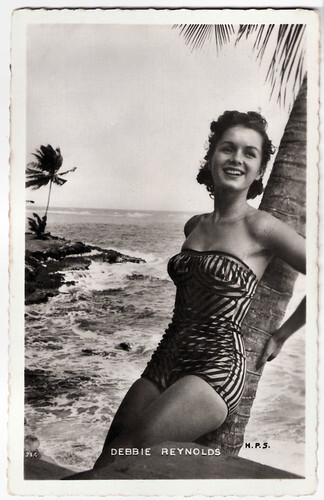
French postcard by Editions P.I., Paris, no. 714. Photo: H.P.S.
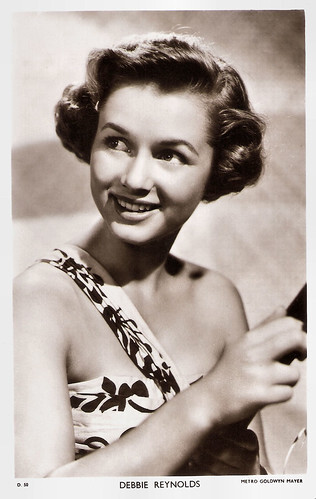
British postcard in the Picturegoer Series, London, no. D 50. Photo: Metro-Goldwyn-Mayer.
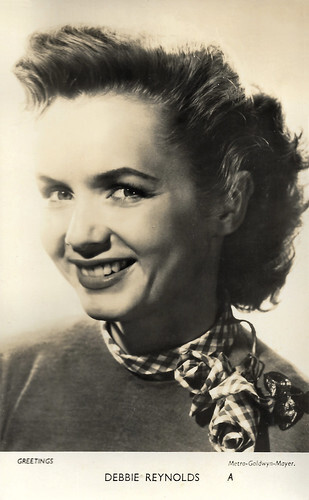
British postcard in the Greetings Series, no. A. Photo: Metro-Goldwyn-Mayer.
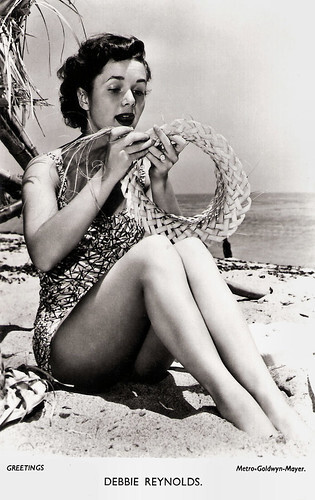
British postcard in the Greetings series. Photo: Metro-Goldwyn-Mayer.
To be with Carrie
Debbie Reynolds' other notable successes include the comedy Susan Slept Here (Frank Tashlin, 1954) starring Dick Powell , Bundle of Joy (Norman Taurog, 1956) for which she received a Golden Globe nomination, The Catered Affair (Richard Brooks, 1956) as the daughter of Bette Davis and Tammy and the Bachelor (Joseph Pevney, 1957) with Leslie Nielsen. Her recording of the Jay Livingston / Ray Evans title song from Tammy and the Bachelor (1957), became a number-one hit for Reynolds in August 1957. In 1959, she starred in the comedy The Mating Game (George Marshall, 1959) with Tony Randall and released her first pop music album, titled 'Debbie'.
She was one of 14 top-billed names in the Western epic How the West Was Won (John Ford, Henry Hathaway, George Marshall, 1963). The family saga covered several decades of Westward expansion in the 19th century, including the Gold Rush, the Civil War, and the building of railroads. She was 31 when she gave an Academy Award-nominated performance as Margaret 'Molly' Brown, who survived the 1912 sinking of the RMS Titanic, in The Unsinkable Molly Brown (Charles Walters, 1964). In 1969, Reynolds starred in a self-titled television program, The Debbie Reynolds Show, earning her a Golden Globe nomination. She also appeared in the Horror film What's the Matter with Helen? (Curtis Harrington, 1971) with Shelley Winters . She also produced the film. Reynolds played the title role in the Hanna-Barbera animated musical Charlotte's Web (Charles A. Nichols, Iwao Takamoto, 1973), in which she originated the song 'Mother Earth and Father Time'.
Reynolds continued to perform successfully on stage, television and film. She made her Broadway debut in 1973 in the revival of 'Irene'. Although the reviews for the show itself were mixed, hers were all raves and she wound up with a Tony Award nomination the following year for Best Actress in a Musical. The production ultimately ran for some 20 months. In 1976, she appeared in a one-woman, short-run (10 days - 14 performances) review named 'Debbie!' at the Minskoff Theatre. Her only other Broadway appearance came when she succeeded Lauren Bacall in 'Woman of the Year' in 1983. Reynolds received a Golden Globe nomination for Mother (Albert Brooks, 1996) as the mother of Albert Brooks. In the following years, she appeared in the comedies In & Out (Frank Oz, 1997) with Kevin Kline and Fear and Loathing in Las Vegas (Terry Gilliam, 1998), starring Johnny Depp .
Her three marriages ended in divorce. In 1959, she survived losing her first husband, musician and actor Eddie Fisher (1955-1959) to her best friend Elizabeth Taylor following the tragic death of Taylor's husband, Michael Todd. News crews were camped out around the clock on Reynolds' front lawn. To ingratiate herself to reporters (and engender public sympathy for her role as the 'wronged wife') Reynolds would regularly grant interviews in front of the house. She often did them with diaper pins on her blouse and her two toddler-aged children, the future producer Todd Fisher and actress Carrie Fisher, in her arms. Her second husband, shoe magnate Harry Karl (1960-1973), gambled away his fortune as well as hers. With her children and Karl's children, she had to keep working and turn to the stage. She had her own casino in Las Vegas with a home for her collection of Hollywood memorabilia until its closure in 1997. Nearly all the money she made was spent toward her goal of creating a Hollywood museum. Her collection numbered more than 3000 costumes and 46,000 square feet worth of props and equipment.
Her third husband was Richard Hamlett (1984-1996). She was awarded a Star on the Hollywood Walk of Fame at 6654 Hollywood Boulevard in Hollywood, California in 1997. On television, she played, among others, Bobby Adler, Grace's mother in the sitcom Will & Grace. Reynolds was nominated for a Primetime Emmy Award for "Outstanding Guest Actress in a Comedy Series" for her role. She reconciled with old nemesis Elizabeth Taylor to work on the made-for-TV movie These Old Broads (2001), written by Debbie's daughter, Carrie Fisher, with Taylor, Shirley MacLaine and Joan Collins . When they began working on These Old Broads together, Taylor told Debbie, "I owe you a lot". Debbie said, "I just got a lump in my throat when she said that". Her final film was the biopic Behind the Candelabra (Steven Soderbergh, 2013) starring Michael Douglas as Liberace . She was awarded the Screen Actors Guild Life Achievement Award in 2014 and the Jean Hersholt Humanitarian Award in 2016. A day after the death of her daughter Carrie Fisher (1956-2016), the 84-year-old Reynolds was rushed to a hospital with a suspected stroke and passed away. Her son, Todd Fisher, said the stress of his sister's death had been too much for her and in her last words, she had said she wanted to be with her daughter. Carrie was cremated and then buried with her mother at Forest Lawn Memorial Park in the Hollywood Hills. Actress and producer Billie Lourd is Debbie Reynold's granddaughter.
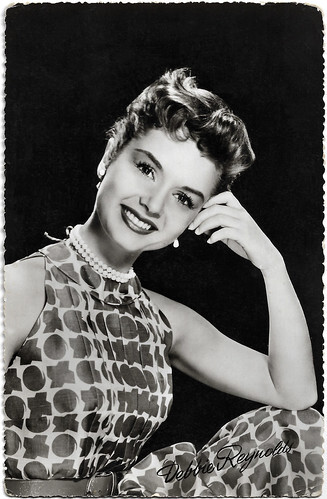
Dutch postcard by DRC, no. F 203. Photo: M.G.M.
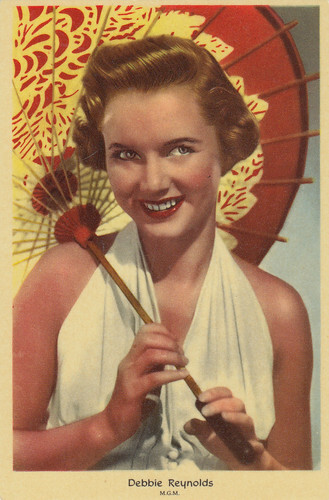
Vintage postcard. Photo: M.G.M. Collection: Marlene Pilaete.
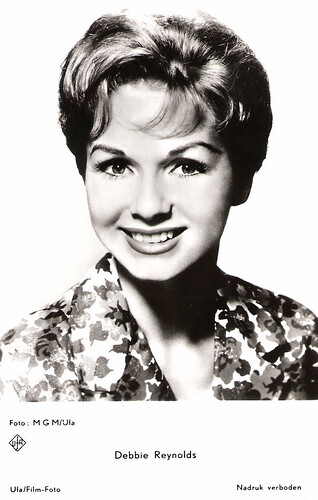
Dutch postcard by Gebr. Spanjersberg N.V., Rotterdam, no. 4664. Sent by mail in 1961. Photo: MGM / Ufa. Collection: Geoffrey Donaldson Institute.
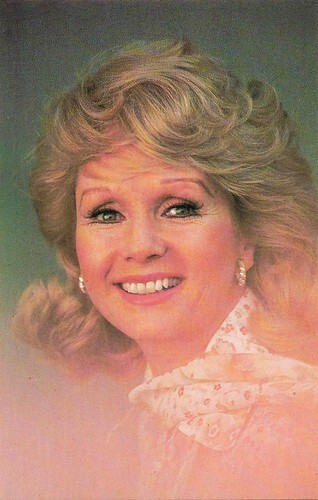
American postcard by Coral-Lee, Rancho Cordova, CAL., no. CL Personality 42, SC18555. Photo: Mike Roberts.
Sources: Hal Erickson (AllMovie), Wikipedia (Dutch and English) and .

German postcard by Krüger, no. 902/21.

West German postcard by ISV, no. B 27. Publicity still for Bundle of Joy (Norman Taurog, 1956).

French postcard by M.D., Paris, no. 114.
Most Promising Newcomer
Debbie Reynolds was born Mary Frances Reynolds in El Paso, Texas, in 1932. She was the second child of Maxine N. (Harmon) and Raymond Francis Reynolds, a carpenter who worked for the Southern Pacific Railroad. In 1939, her family moved to Burbank, California. Debbie played the French horn in high school and was a member of the Burbank Youth Symphony.
She planned to go teaching physical education, but the day after she won the 1948 Miss Burbank contest at age 16 impersonating Betty Hutton , Warner Bros. offered her a screen test. Although she wanted to be in show business, the Reynolds family church, the Nazarene, forbade acting. However, Reynolds' father saw her talent and gave his support, seeing it as a means of paying her college costs. In 1950, she graduated from Burbank High School.
Warner Bros gave her a new first name and her first roles in films. When Warner Bros. stopped producing musicals in 1950, she moved to MGM. Her breakout role was Helen Kane in the musical Three Little Words (Richard Thorpe, 1950), about the successful Tin Pan Alley songwriting team of Bert Kalmar ( Fred Astaire ) and Harry Ruby (Red Skelton). Reynolds was nominated for the Golden Globe for Most Promising Newcomer. Her song 'Aba Daba Honeymoon', featured in the film Two Weeks with Love (Roy Rowland, 1950) and sung as a duet with co-star Carleton Carpenter, was the first soundtrack recording to become a top-of-the-chart gold record. It reached number three on the Billboard charts. Her performance in the film greatly impressed the studio, which then gave her a co-starring role in what became her highest-profile film.
At age 19, Debbie Reynolds played her first co-starring role as Kathy Selden in Singin' in the Rain (Stanley Donen, Gene Kelly, 1952). The musical offers a lighthearted depiction of Hollywood in the late 1920s, with Gene Kelly , Donald O'Connor and Reynolds portraying performers caught up in the transition from silent films to 'talkies'. Reynolds wasn't a dancer until she was selected to be Gene Kelly 's partner in this musical. Not yet twenty, she was a quick study. Hal Erickson at AllMovie : "On the strength of the plot alone, concocted by the matchless writing team of Betty Comden and Adolph Green, Singin' in the Rain is a delight. But with the addition of MGM's catalogue of Arthur Freed-Nacio Herb Brown songs - 'You Were Meant for Me', 'You Are My Lucky Star', 'The Broadway Melody', and of course the title song - the film becomes one of the greatest Hollywood musicals ever made."
By the mid-1950s, Debbie Reynolds was a major star and it seemed like she had been around forever. Most of her early film work was in MGM musicals, as perky, wholesome young women, such as I Love Melvin (Don Weis, 1953) with Donald O'Connor , The Affairs of Dobie Gillis (Don Weis, 1953) with Bobby Van and Bob Fosse, and Give a Girl a Break (Stanley Donen, 1953) starring Reynolds and the dance team of Marge and Gower Champion. She continued to use her dancing skills with stage work.

French postcard by Editions P.I., Paris, no. 714. Photo: H.P.S.

British postcard in the Picturegoer Series, London, no. D 50. Photo: Metro-Goldwyn-Mayer.

British postcard in the Greetings Series, no. A. Photo: Metro-Goldwyn-Mayer.

British postcard in the Greetings series. Photo: Metro-Goldwyn-Mayer.
To be with Carrie
Debbie Reynolds' other notable successes include the comedy Susan Slept Here (Frank Tashlin, 1954) starring Dick Powell , Bundle of Joy (Norman Taurog, 1956) for which she received a Golden Globe nomination, The Catered Affair (Richard Brooks, 1956) as the daughter of Bette Davis and Tammy and the Bachelor (Joseph Pevney, 1957) with Leslie Nielsen. Her recording of the Jay Livingston / Ray Evans title song from Tammy and the Bachelor (1957), became a number-one hit for Reynolds in August 1957. In 1959, she starred in the comedy The Mating Game (George Marshall, 1959) with Tony Randall and released her first pop music album, titled 'Debbie'.
She was one of 14 top-billed names in the Western epic How the West Was Won (John Ford, Henry Hathaway, George Marshall, 1963). The family saga covered several decades of Westward expansion in the 19th century, including the Gold Rush, the Civil War, and the building of railroads. She was 31 when she gave an Academy Award-nominated performance as Margaret 'Molly' Brown, who survived the 1912 sinking of the RMS Titanic, in The Unsinkable Molly Brown (Charles Walters, 1964). In 1969, Reynolds starred in a self-titled television program, The Debbie Reynolds Show, earning her a Golden Globe nomination. She also appeared in the Horror film What's the Matter with Helen? (Curtis Harrington, 1971) with Shelley Winters . She also produced the film. Reynolds played the title role in the Hanna-Barbera animated musical Charlotte's Web (Charles A. Nichols, Iwao Takamoto, 1973), in which she originated the song 'Mother Earth and Father Time'.
Reynolds continued to perform successfully on stage, television and film. She made her Broadway debut in 1973 in the revival of 'Irene'. Although the reviews for the show itself were mixed, hers were all raves and she wound up with a Tony Award nomination the following year for Best Actress in a Musical. The production ultimately ran for some 20 months. In 1976, she appeared in a one-woman, short-run (10 days - 14 performances) review named 'Debbie!' at the Minskoff Theatre. Her only other Broadway appearance came when she succeeded Lauren Bacall in 'Woman of the Year' in 1983. Reynolds received a Golden Globe nomination for Mother (Albert Brooks, 1996) as the mother of Albert Brooks. In the following years, she appeared in the comedies In & Out (Frank Oz, 1997) with Kevin Kline and Fear and Loathing in Las Vegas (Terry Gilliam, 1998), starring Johnny Depp .
Her three marriages ended in divorce. In 1959, she survived losing her first husband, musician and actor Eddie Fisher (1955-1959) to her best friend Elizabeth Taylor following the tragic death of Taylor's husband, Michael Todd. News crews were camped out around the clock on Reynolds' front lawn. To ingratiate herself to reporters (and engender public sympathy for her role as the 'wronged wife') Reynolds would regularly grant interviews in front of the house. She often did them with diaper pins on her blouse and her two toddler-aged children, the future producer Todd Fisher and actress Carrie Fisher, in her arms. Her second husband, shoe magnate Harry Karl (1960-1973), gambled away his fortune as well as hers. With her children and Karl's children, she had to keep working and turn to the stage. She had her own casino in Las Vegas with a home for her collection of Hollywood memorabilia until its closure in 1997. Nearly all the money she made was spent toward her goal of creating a Hollywood museum. Her collection numbered more than 3000 costumes and 46,000 square feet worth of props and equipment.
Her third husband was Richard Hamlett (1984-1996). She was awarded a Star on the Hollywood Walk of Fame at 6654 Hollywood Boulevard in Hollywood, California in 1997. On television, she played, among others, Bobby Adler, Grace's mother in the sitcom Will & Grace. Reynolds was nominated for a Primetime Emmy Award for "Outstanding Guest Actress in a Comedy Series" for her role. She reconciled with old nemesis Elizabeth Taylor to work on the made-for-TV movie These Old Broads (2001), written by Debbie's daughter, Carrie Fisher, with Taylor, Shirley MacLaine and Joan Collins . When they began working on These Old Broads together, Taylor told Debbie, "I owe you a lot". Debbie said, "I just got a lump in my throat when she said that". Her final film was the biopic Behind the Candelabra (Steven Soderbergh, 2013) starring Michael Douglas as Liberace . She was awarded the Screen Actors Guild Life Achievement Award in 2014 and the Jean Hersholt Humanitarian Award in 2016. A day after the death of her daughter Carrie Fisher (1956-2016), the 84-year-old Reynolds was rushed to a hospital with a suspected stroke and passed away. Her son, Todd Fisher, said the stress of his sister's death had been too much for her and in her last words, she had said she wanted to be with her daughter. Carrie was cremated and then buried with her mother at Forest Lawn Memorial Park in the Hollywood Hills. Actress and producer Billie Lourd is Debbie Reynold's granddaughter.

Dutch postcard by DRC, no. F 203. Photo: M.G.M.

Vintage postcard. Photo: M.G.M. Collection: Marlene Pilaete.

Dutch postcard by Gebr. Spanjersberg N.V., Rotterdam, no. 4664. Sent by mail in 1961. Photo: MGM / Ufa. Collection: Geoffrey Donaldson Institute.

American postcard by Coral-Lee, Rancho Cordova, CAL., no. CL Personality 42, SC18555. Photo: Mike Roberts.
Sources: Hal Erickson (AllMovie), Wikipedia (Dutch and English) and .
Published on April 19, 2024 22:00
April 17, 2024
Les Misérables (2012)
Les Misérables (Tom Hooper, 2012) is a well-executed, powerful film musical. The screenplay by William Nicholson, Alain Boublil, Claude-Michel Schönberg, and Herbert Kretzmer, is based on the stage musical of the same name by Schönberg, Boublil, and Jean-Marc Natel, which in turn is based on the epic novel 'Les Misérables' (1862) by Victor Hugo. The film was nominated for eight Oscars, winning three.
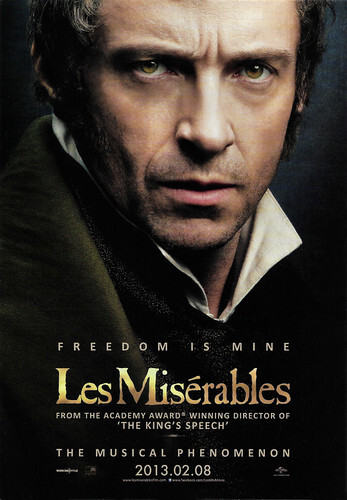
Taiwanese postcard by CoolCard, 2013. Photo: Ignition, Los Angeles / Working Title / Universal. Hugh Jackman as Jean Valjean in Les Misérables (Tom Hooper, 2012). Caption: Freedom is Mine. From the Academy Award-winning director of 'The King's Speech'. The Musical Phenomenon.
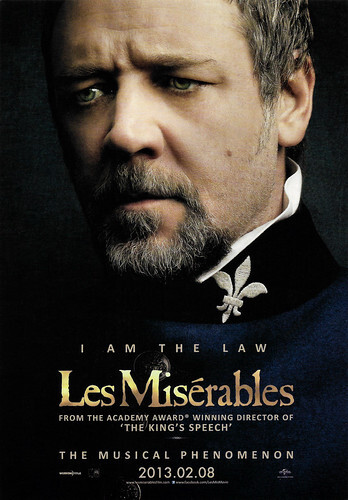
Taiwanese postcard by CoolCard, 2013. Photo: Ignition, Los Angeles / Working Title / Universal. Russell Crowe as Javert in Les Misérables (Tom Hooper, 2012). Caption: I am the Law. From the Academy Award-winning director of 'The King's Speech'. The Musical Phenomenon.
A decision that changes their lives forever
In 1815, French prisoner 24601, Jean Valjean (Hugh Jackman) was released from the Bagne of Toulon after a nineteen-year sentence for stealing bread to feed his sister's child. His paroled status prevents him from finding work or accommodation, but he is sheltered by the kindly Bishop of Digne.
Valjean attempts to steal his silverware and is captured, but the bishop, in radical grace, claims he gave him the silver and tells him to use it to begin an honest life. Moved, Valjean breaks his parole and assumes a new identity, intending to redeem others.
For decades he is hunted by the ruthless and persistent Inspector Javert (Russell Crowe). Then the fugitive promises dying prostitute Fantine (Anne Hathaway) to take care of her little daughter, Cosette (Amanda Seyfried). The decision changes their lives forever.
Set in post-revolutionary France, the story resolves to the background of the June Rebellion of 1832. In his huge epic novel of 1500 pages, Victor Hugo's 'Les Misérables' featured many characters and covered many decades and several grand themes. It's impossible to cram this all into a 2.5-hour film. 'Les Mis' has been filmed several times and the latest BBC series from 2018 was a 6-hour in-depth version. But this 2012 adaptation is the first film version of the immensely popular Cameron Mackintosh musical which ran for 27 years and had a total audience of over 60 million.
'Les Mis' is not the most accessible of musicals. It is lengthy and the quite heavy story feels like an opera. Following the release of the stage musical, a film adaptation was mired in development hell for over ten years. The rights were passed on to several major studios, and various directors including Alan Parker and Bruce Beresford were considered. In 2011, Mackintosh finally sold the film rights to Eric Fellner, who financed the film with Tim Bevan and Debra Hayward through their production company Working Title Films. As the director, they wanted the Brit Tom Hooper, who had just made the acclaimed historical drama The King's Speech (2010).
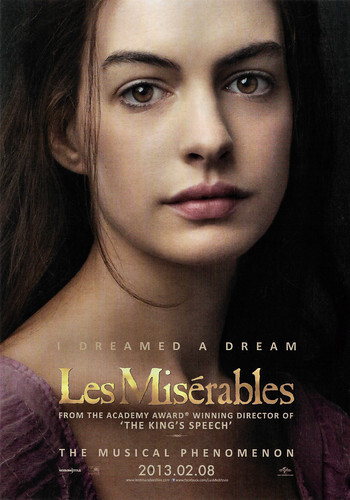
Taiwanese postcard by CoolCard, 2013. Photo: Ignition, Los Angeles / Working Title / Universal. Anne Hathaway as Fantine in Les Misérables (Tom Hooper, 2012). Caption: I dreamed a dream. From the Academy Award winning director of 'The King's Speech'. The musical phenomenon.
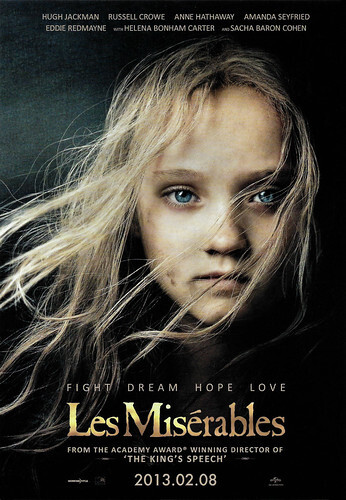
Taiwanese postcard by CoolCard, 2013. Photo: Ignition, Los Angeles / Working Title / Universal. Isabelle Allen as young Cosette in Les Misérables (Tom Hooper, 2012). Caption: Fight Dream Hope Love. From the Academy Award-winning director of 'The King's Speech'.
A surrealistic, nightmarish Paris
For his Les Misérables (2012), Tom Hooper chose an incomplete rendering of the musical. He went for depth and context so one can truly appreciate the tragedy and the themes. His film is a bold and commendable attempt at converting the musical to a film format.
Even more daring was Hooper's insistence to make a film in which all the dialogue was sung live and the actors could sing as if they were acting. In several lines, Hugh Jackman almost speaks rather than truly sings, because he is trying to do the songs in a more realistic acting fashion. This works best in Anne Hathaway's song 'I Dreamed a Dream'. Her raw, emotional rendition works perfectly for her devastatingly human portrayal of Fantine. Hathaway won an Oscar for it.
The casting is mostly good. Jackman is an excellent Valjean, vulnerable and strong. He believes. He emotes. He is as big as the story itself. Jackson deservedly received an Oscar nomination for his performance. Russell Crowe is also fine as Javert, the obsessive and punitive policeman who mercilessly hounds Jean Valjean. Sacha Baron Cohen and Helena Bonham Carter give bravura performances as the hilarious Thénardier innkeepers. In an almost three-hour show, Hooper, writer Claude-Michel Schonberg and cinematographer Danny Cohen keep the action moving. Hooper skillfully created a surrealistic, nightmarish Paris for Fantine. The extremely heightened realism is on the verge of being surrealistic. The close-ups create a kind of intimacy which provides opportunities for the actors to do their work.
The result is personal and intense. Peter Bradshaw in The Guardian : "It conquers its audience with weapons all its own: not passion so much as passionate sincerity, not power so much as overwhelming force. Every line, every note, every scene is belted out with diaphragm-quivering conviction and unbroken, unremitting intensity. The physical strength of this movie is impressive: an awe-inspiring and colossal effort, just like Valjean's as he lifts the flagpole at the beginning of the film. You can almost see the movie's muscles flexing and the veins standing out like whipcords on its forehead. At the end of 158 minutes, you have experienced something."
The film grossed over $442 million worldwide against a production budget of $61 million during its original theatrical run. In anticipation of the stage musical's forthcoming 40th anniversary in 2025, the film is digitally remixed and remastered in Dolby Vision and Dolby Atmos. Cameron Mackintosh, Tom Hooper, music producer Lee McCutcheon, music director Stephen Metcalfe and sound mixer Andy Nelson all supervised the Dolby Atmos remix for this 2024 version.
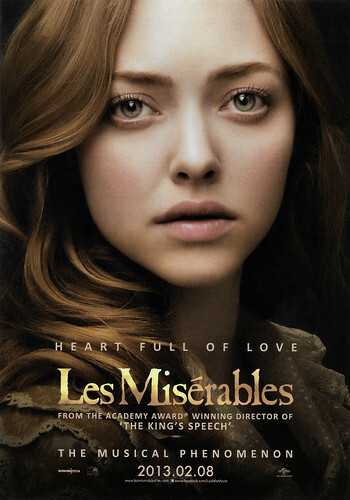
Taiwanese postcard by CoolCard, 2013. Photo: Ignition, Los Angeles / Working Title / Universal. Amanda Seyfried as Cosette in Les Misérables (Tom Hooper, 2012). Caption: Heart full of love. From the Academy Award-winning director of 'The King's Speech'. The musical phenomenon.
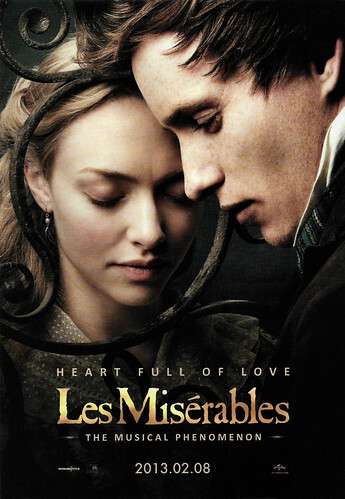
Taiwanese postcard by CoolCard, 2013. Photo: Ignition, Los Angeles / Working Title / Universal. Amanda Seyfried as Cosette and Eddie Redmayne as Marius in Les Misérables (Tom Hooper, 2012). Caption: Heart Full of Love. The Musical Phenomenon.
Sources: Peter Bradshaw (The Guardian), Wikipedia and IMDb.

Taiwanese postcard by CoolCard, 2013. Photo: Ignition, Los Angeles / Working Title / Universal. Hugh Jackman as Jean Valjean in Les Misérables (Tom Hooper, 2012). Caption: Freedom is Mine. From the Academy Award-winning director of 'The King's Speech'. The Musical Phenomenon.

Taiwanese postcard by CoolCard, 2013. Photo: Ignition, Los Angeles / Working Title / Universal. Russell Crowe as Javert in Les Misérables (Tom Hooper, 2012). Caption: I am the Law. From the Academy Award-winning director of 'The King's Speech'. The Musical Phenomenon.
A decision that changes their lives forever
In 1815, French prisoner 24601, Jean Valjean (Hugh Jackman) was released from the Bagne of Toulon after a nineteen-year sentence for stealing bread to feed his sister's child. His paroled status prevents him from finding work or accommodation, but he is sheltered by the kindly Bishop of Digne.
Valjean attempts to steal his silverware and is captured, but the bishop, in radical grace, claims he gave him the silver and tells him to use it to begin an honest life. Moved, Valjean breaks his parole and assumes a new identity, intending to redeem others.
For decades he is hunted by the ruthless and persistent Inspector Javert (Russell Crowe). Then the fugitive promises dying prostitute Fantine (Anne Hathaway) to take care of her little daughter, Cosette (Amanda Seyfried). The decision changes their lives forever.
Set in post-revolutionary France, the story resolves to the background of the June Rebellion of 1832. In his huge epic novel of 1500 pages, Victor Hugo's 'Les Misérables' featured many characters and covered many decades and several grand themes. It's impossible to cram this all into a 2.5-hour film. 'Les Mis' has been filmed several times and the latest BBC series from 2018 was a 6-hour in-depth version. But this 2012 adaptation is the first film version of the immensely popular Cameron Mackintosh musical which ran for 27 years and had a total audience of over 60 million.
'Les Mis' is not the most accessible of musicals. It is lengthy and the quite heavy story feels like an opera. Following the release of the stage musical, a film adaptation was mired in development hell for over ten years. The rights were passed on to several major studios, and various directors including Alan Parker and Bruce Beresford were considered. In 2011, Mackintosh finally sold the film rights to Eric Fellner, who financed the film with Tim Bevan and Debra Hayward through their production company Working Title Films. As the director, they wanted the Brit Tom Hooper, who had just made the acclaimed historical drama The King's Speech (2010).

Taiwanese postcard by CoolCard, 2013. Photo: Ignition, Los Angeles / Working Title / Universal. Anne Hathaway as Fantine in Les Misérables (Tom Hooper, 2012). Caption: I dreamed a dream. From the Academy Award winning director of 'The King's Speech'. The musical phenomenon.

Taiwanese postcard by CoolCard, 2013. Photo: Ignition, Los Angeles / Working Title / Universal. Isabelle Allen as young Cosette in Les Misérables (Tom Hooper, 2012). Caption: Fight Dream Hope Love. From the Academy Award-winning director of 'The King's Speech'.
A surrealistic, nightmarish Paris
For his Les Misérables (2012), Tom Hooper chose an incomplete rendering of the musical. He went for depth and context so one can truly appreciate the tragedy and the themes. His film is a bold and commendable attempt at converting the musical to a film format.
Even more daring was Hooper's insistence to make a film in which all the dialogue was sung live and the actors could sing as if they were acting. In several lines, Hugh Jackman almost speaks rather than truly sings, because he is trying to do the songs in a more realistic acting fashion. This works best in Anne Hathaway's song 'I Dreamed a Dream'. Her raw, emotional rendition works perfectly for her devastatingly human portrayal of Fantine. Hathaway won an Oscar for it.
The casting is mostly good. Jackman is an excellent Valjean, vulnerable and strong. He believes. He emotes. He is as big as the story itself. Jackson deservedly received an Oscar nomination for his performance. Russell Crowe is also fine as Javert, the obsessive and punitive policeman who mercilessly hounds Jean Valjean. Sacha Baron Cohen and Helena Bonham Carter give bravura performances as the hilarious Thénardier innkeepers. In an almost three-hour show, Hooper, writer Claude-Michel Schonberg and cinematographer Danny Cohen keep the action moving. Hooper skillfully created a surrealistic, nightmarish Paris for Fantine. The extremely heightened realism is on the verge of being surrealistic. The close-ups create a kind of intimacy which provides opportunities for the actors to do their work.
The result is personal and intense. Peter Bradshaw in The Guardian : "It conquers its audience with weapons all its own: not passion so much as passionate sincerity, not power so much as overwhelming force. Every line, every note, every scene is belted out with diaphragm-quivering conviction and unbroken, unremitting intensity. The physical strength of this movie is impressive: an awe-inspiring and colossal effort, just like Valjean's as he lifts the flagpole at the beginning of the film. You can almost see the movie's muscles flexing and the veins standing out like whipcords on its forehead. At the end of 158 minutes, you have experienced something."
The film grossed over $442 million worldwide against a production budget of $61 million during its original theatrical run. In anticipation of the stage musical's forthcoming 40th anniversary in 2025, the film is digitally remixed and remastered in Dolby Vision and Dolby Atmos. Cameron Mackintosh, Tom Hooper, music producer Lee McCutcheon, music director Stephen Metcalfe and sound mixer Andy Nelson all supervised the Dolby Atmos remix for this 2024 version.

Taiwanese postcard by CoolCard, 2013. Photo: Ignition, Los Angeles / Working Title / Universal. Amanda Seyfried as Cosette in Les Misérables (Tom Hooper, 2012). Caption: Heart full of love. From the Academy Award-winning director of 'The King's Speech'. The musical phenomenon.

Taiwanese postcard by CoolCard, 2013. Photo: Ignition, Los Angeles / Working Title / Universal. Amanda Seyfried as Cosette and Eddie Redmayne as Marius in Les Misérables (Tom Hooper, 2012). Caption: Heart Full of Love. The Musical Phenomenon.
Sources: Peter Bradshaw (The Guardian), Wikipedia and IMDb.
Published on April 17, 2024 22:00
Paul van Yperen's Blog
- Paul van Yperen's profile
- 13 followers
Paul van Yperen isn't a Goodreads Author
(yet),
but they
do have a blog,
so here are some recent posts imported from
their feed.



